Impact of Politics, Culture, and Power on Performance and Behavior
VerifiedAdded on 2022/12/28
|20
|6571
|1
AI Summary
This report analyzes the impact of politics, culture, and power on the performance and behavior of individuals and teams in an organization. It also evaluates how organizations influence the behavior of individuals and teams. The report assesses the helpfulness of content and process theories of motivation. The case study is based on Marks & Spencer, a British multinational retailer company.
Contribute Materials
Your contribution can guide someone’s learning journey. Share your
documents today.
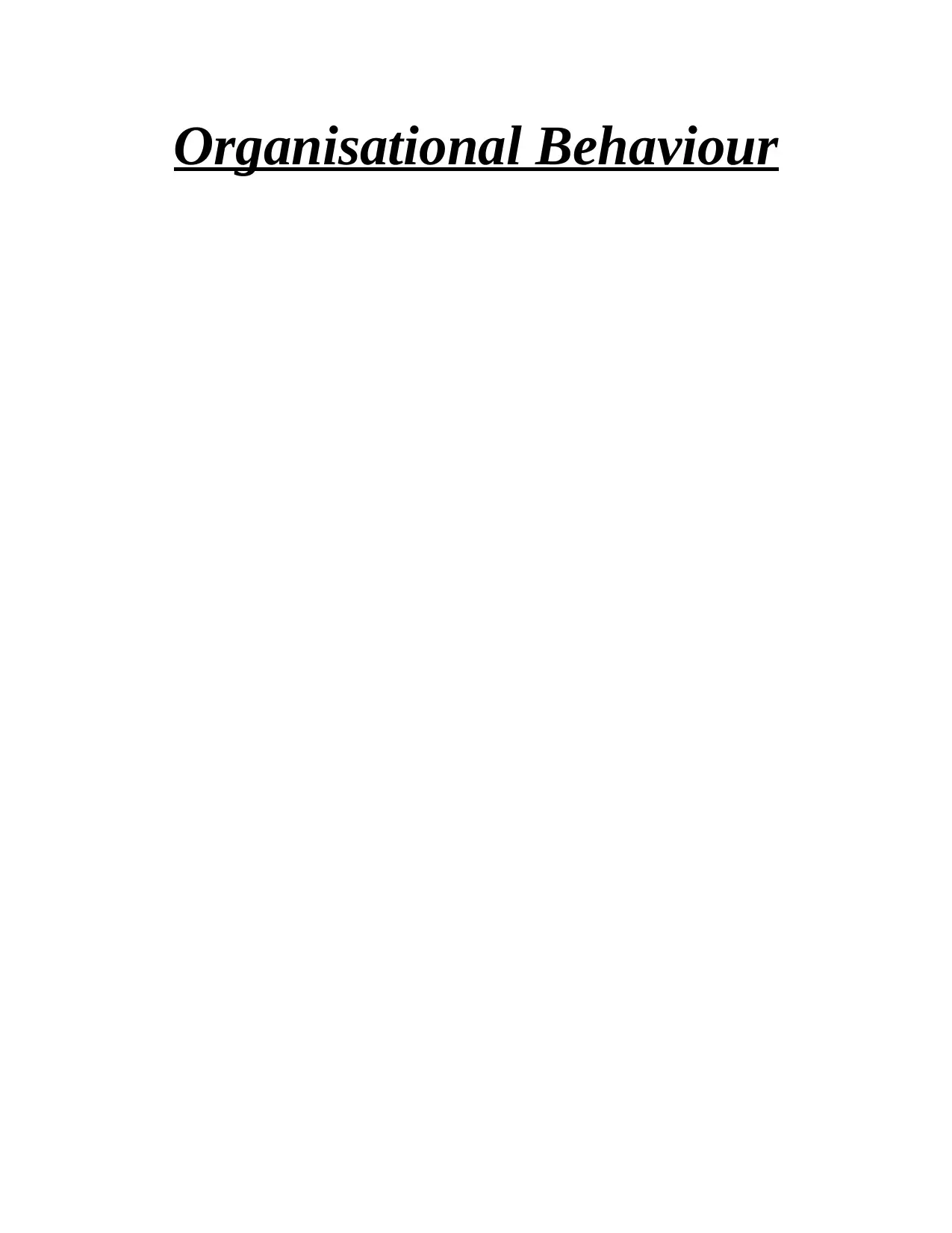
Organisational Behaviour
Secure Best Marks with AI Grader
Need help grading? Try our AI Grader for instant feedback on your assignments.
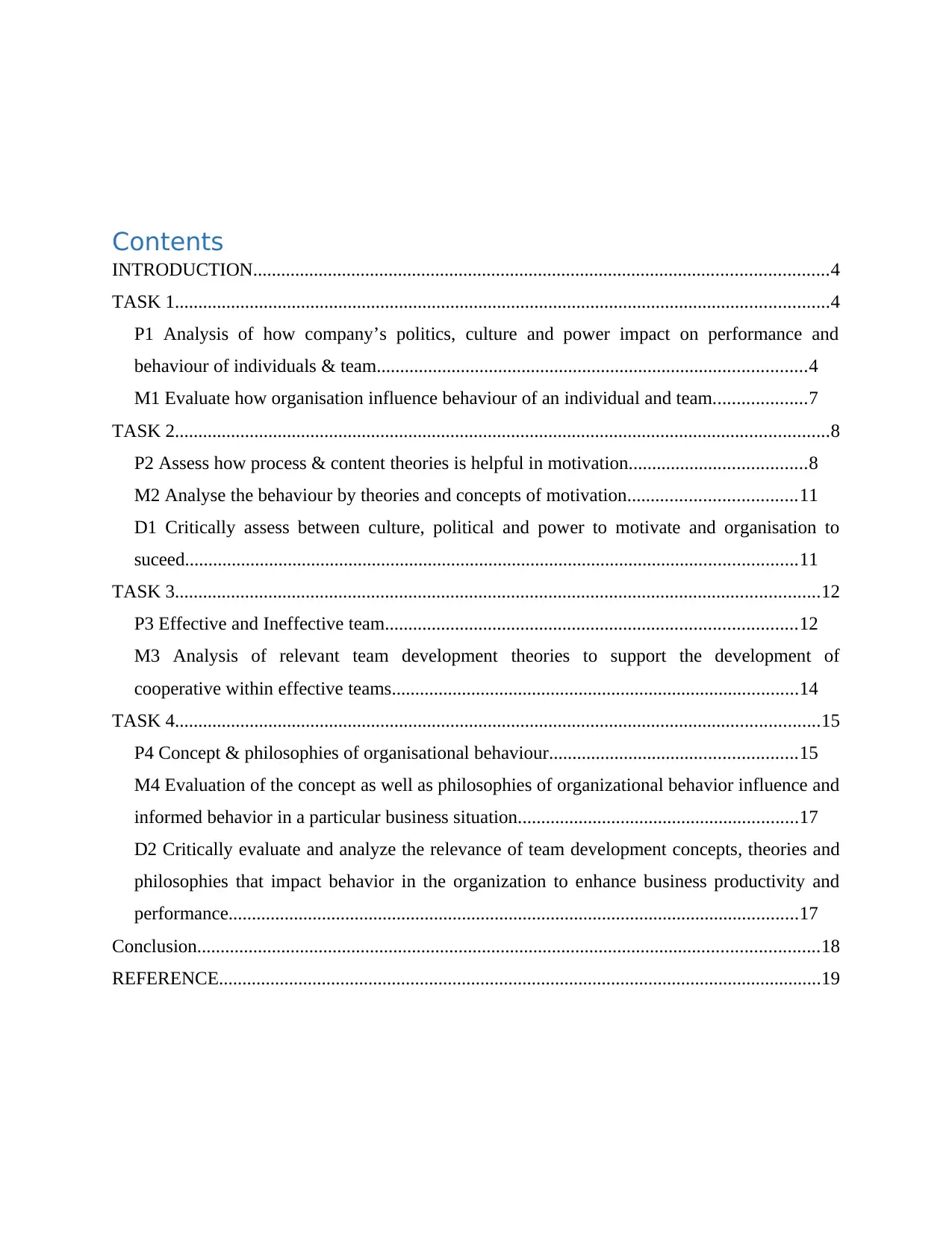
Contents
INTRODUCTION...........................................................................................................................4
TASK 1............................................................................................................................................4
P1 Analysis of how company’s politics, culture and power impact on performance and
behaviour of individuals & team............................................................................................4
M1 Evaluate how organisation influence behaviour of an individual and team....................7
TASK 2............................................................................................................................................8
P2 Assess how process & content theories is helpful in motivation......................................8
M2 Analyse the behaviour by theories and concepts of motivation....................................11
D1 Critically assess between culture, political and power to motivate and organisation to
suceed...................................................................................................................................11
TASK 3..........................................................................................................................................12
P3 Effective and Ineffective team........................................................................................12
M3 Analysis of relevant team development theories to support the development of
cooperative within effective teams.......................................................................................14
TASK 4..........................................................................................................................................15
P4 Concept & philosophies of organisational behaviour.....................................................15
M4 Evaluation of the concept as well as philosophies of organizational behavior influence and
informed behavior in a particular business situation............................................................17
D2 Critically evaluate and analyze the relevance of team development concepts, theories and
philosophies that impact behavior in the organization to enhance business productivity and
performance..........................................................................................................................17
Conclusion.....................................................................................................................................18
REFERENCE.................................................................................................................................19
INTRODUCTION...........................................................................................................................4
TASK 1............................................................................................................................................4
P1 Analysis of how company’s politics, culture and power impact on performance and
behaviour of individuals & team............................................................................................4
M1 Evaluate how organisation influence behaviour of an individual and team....................7
TASK 2............................................................................................................................................8
P2 Assess how process & content theories is helpful in motivation......................................8
M2 Analyse the behaviour by theories and concepts of motivation....................................11
D1 Critically assess between culture, political and power to motivate and organisation to
suceed...................................................................................................................................11
TASK 3..........................................................................................................................................12
P3 Effective and Ineffective team........................................................................................12
M3 Analysis of relevant team development theories to support the development of
cooperative within effective teams.......................................................................................14
TASK 4..........................................................................................................................................15
P4 Concept & philosophies of organisational behaviour.....................................................15
M4 Evaluation of the concept as well as philosophies of organizational behavior influence and
informed behavior in a particular business situation............................................................17
D2 Critically evaluate and analyze the relevance of team development concepts, theories and
philosophies that impact behavior in the organization to enhance business productivity and
performance..........................................................................................................................17
Conclusion.....................................................................................................................................18
REFERENCE.................................................................................................................................19

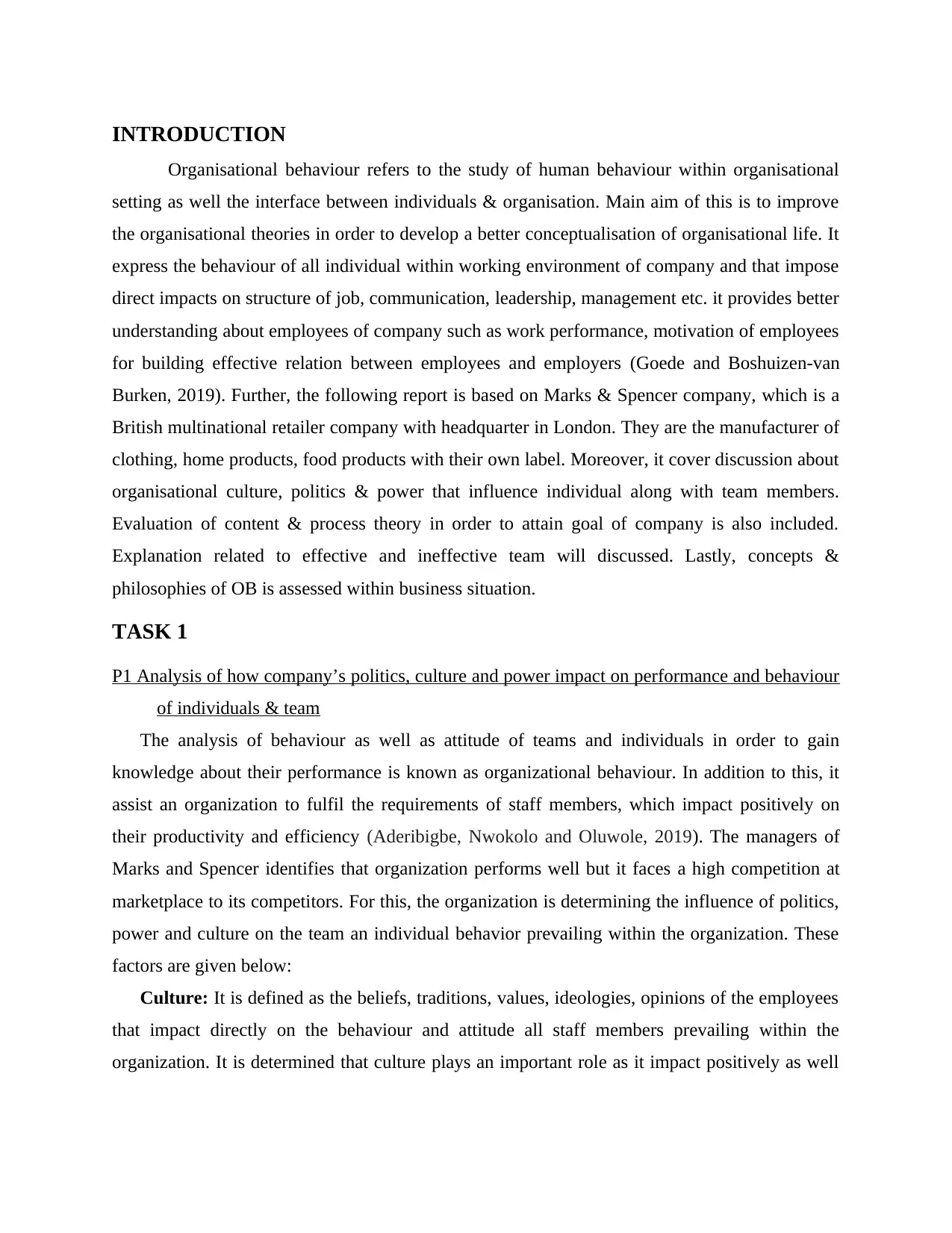
INTRODUCTION
Organisational behaviour refers to the study of human behaviour within organisational
setting as well the interface between individuals & organisation. Main aim of this is to improve
the organisational theories in order to develop a better conceptualisation of organisational life. It
express the behaviour of all individual within working environment of company and that impose
direct impacts on structure of job, communication, leadership, management etc. it provides better
understanding about employees of company such as work performance, motivation of employees
for building effective relation between employees and employers (Goede and Boshuizen‐van
Burken, 2019). Further, the following report is based on Marks & Spencer company, which is a
British multinational retailer company with headquarter in London. They are the manufacturer of
clothing, home products, food products with their own label. Moreover, it cover discussion about
organisational culture, politics & power that influence individual along with team members.
Evaluation of content & process theory in order to attain goal of company is also included.
Explanation related to effective and ineffective team will discussed. Lastly, concepts &
philosophies of OB is assessed within business situation.
TASK 1
P1 Analysis of how company’s politics, culture and power impact on performance and behaviour
of individuals & team
The analysis of behaviour as well as attitude of teams and individuals in order to gain
knowledge about their performance is known as organizational behaviour. In addition to this, it
assist an organization to fulfil the requirements of staff members, which impact positively on
their productivity and efficiency (Aderibigbe, Nwokolo and Oluwole, 2019). The managers of
Marks and Spencer identifies that organization performs well but it faces a high competition at
marketplace to its competitors. For this, the organization is determining the influence of politics,
power and culture on the team an individual behavior prevailing within the organization. These
factors are given below:
Culture: It is defined as the beliefs, traditions, values, ideologies, opinions of the employees
that impact directly on the behaviour and attitude all staff members prevailing within the
organization. It is determined that culture plays an important role as it impact positively as well
Organisational behaviour refers to the study of human behaviour within organisational
setting as well the interface between individuals & organisation. Main aim of this is to improve
the organisational theories in order to develop a better conceptualisation of organisational life. It
express the behaviour of all individual within working environment of company and that impose
direct impacts on structure of job, communication, leadership, management etc. it provides better
understanding about employees of company such as work performance, motivation of employees
for building effective relation between employees and employers (Goede and Boshuizen‐van
Burken, 2019). Further, the following report is based on Marks & Spencer company, which is a
British multinational retailer company with headquarter in London. They are the manufacturer of
clothing, home products, food products with their own label. Moreover, it cover discussion about
organisational culture, politics & power that influence individual along with team members.
Evaluation of content & process theory in order to attain goal of company is also included.
Explanation related to effective and ineffective team will discussed. Lastly, concepts &
philosophies of OB is assessed within business situation.
TASK 1
P1 Analysis of how company’s politics, culture and power impact on performance and behaviour
of individuals & team
The analysis of behaviour as well as attitude of teams and individuals in order to gain
knowledge about their performance is known as organizational behaviour. In addition to this, it
assist an organization to fulfil the requirements of staff members, which impact positively on
their productivity and efficiency (Aderibigbe, Nwokolo and Oluwole, 2019). The managers of
Marks and Spencer identifies that organization performs well but it faces a high competition at
marketplace to its competitors. For this, the organization is determining the influence of politics,
power and culture on the team an individual behavior prevailing within the organization. These
factors are given below:
Culture: It is defined as the beliefs, traditions, values, ideologies, opinions of the employees
that impact directly on the behaviour and attitude all staff members prevailing within the
organization. It is determined that culture plays an important role as it impact positively as well
Secure Best Marks with AI Grader
Need help grading? Try our AI Grader for instant feedback on your assignments.
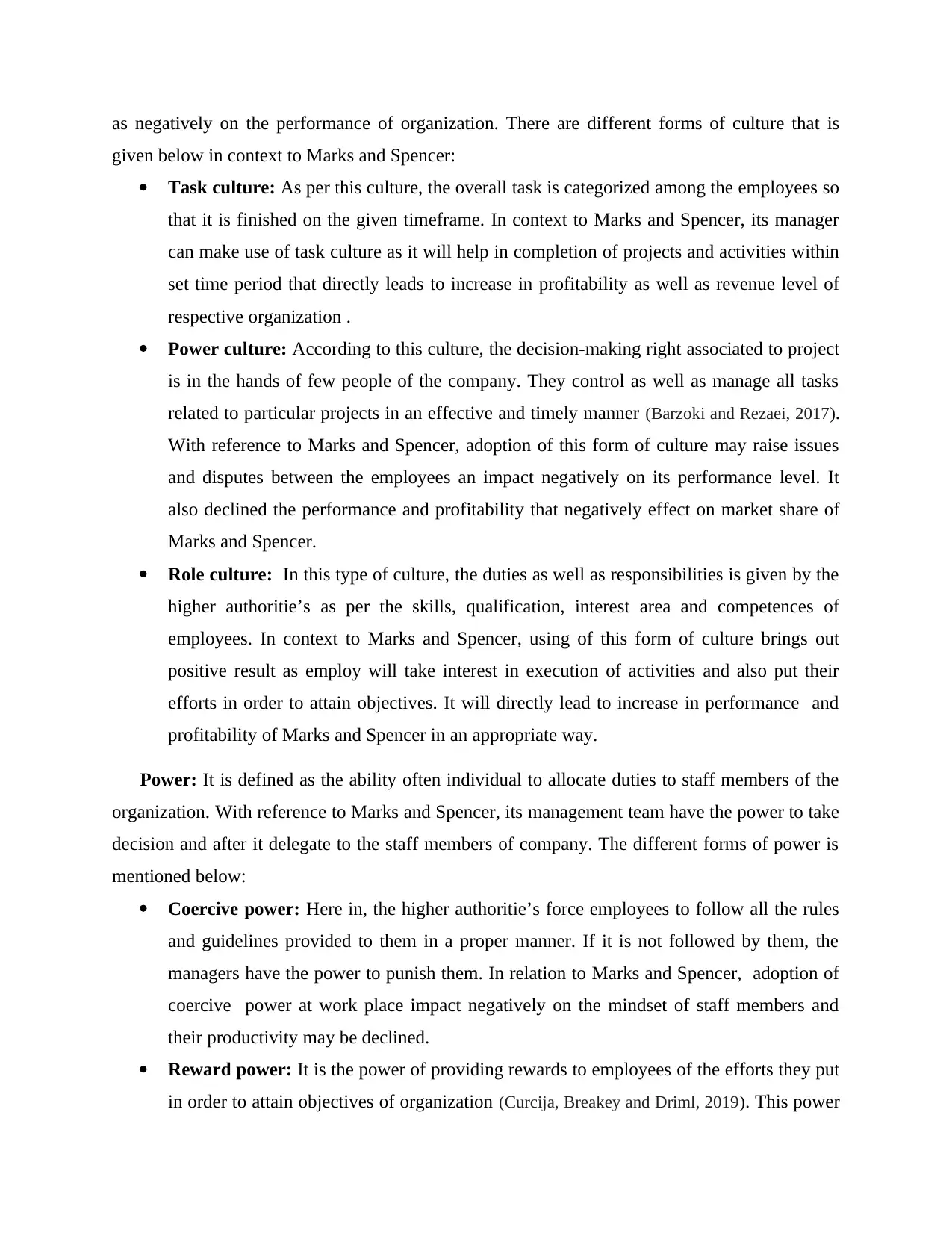
as negatively on the performance of organization. There are different forms of culture that is
given below in context to Marks and Spencer:
Task culture: As per this culture, the overall task is categorized among the employees so
that it is finished on the given timeframe. In context to Marks and Spencer, its manager
can make use of task culture as it will help in completion of projects and activities within
set time period that directly leads to increase in profitability as well as revenue level of
respective organization .
Power culture: According to this culture, the decision-making right associated to project
is in the hands of few people of the company. They control as well as manage all tasks
related to particular projects in an effective and timely manner (Barzoki and Rezaei, 2017).
With reference to Marks and Spencer, adoption of this form of culture may raise issues
and disputes between the employees an impact negatively on its performance level. It
also declined the performance and profitability that negatively effect on market share of
Marks and Spencer.
Role culture: In this type of culture, the duties as well as responsibilities is given by the
higher authoritie’s as per the skills, qualification, interest area and competences of
employees. In context to Marks and Spencer, using of this form of culture brings out
positive result as employ will take interest in execution of activities and also put their
efforts in order to attain objectives. It will directly lead to increase in performance and
profitability of Marks and Spencer in an appropriate way.
Power: It is defined as the ability often individual to allocate duties to staff members of the
organization. With reference to Marks and Spencer, its management team have the power to take
decision and after it delegate to the staff members of company. The different forms of power is
mentioned below:
Coercive power: Here in, the higher authoritie’s force employees to follow all the rules
and guidelines provided to them in a proper manner. If it is not followed by them, the
managers have the power to punish them. In relation to Marks and Spencer, adoption of
coercive power at work place impact negatively on the mindset of staff members and
their productivity may be declined.
Reward power: It is the power of providing rewards to employees of the efforts they put
in order to attain objectives of organization (Curcija, Breakey and Driml, 2019). This power
given below in context to Marks and Spencer:
Task culture: As per this culture, the overall task is categorized among the employees so
that it is finished on the given timeframe. In context to Marks and Spencer, its manager
can make use of task culture as it will help in completion of projects and activities within
set time period that directly leads to increase in profitability as well as revenue level of
respective organization .
Power culture: According to this culture, the decision-making right associated to project
is in the hands of few people of the company. They control as well as manage all tasks
related to particular projects in an effective and timely manner (Barzoki and Rezaei, 2017).
With reference to Marks and Spencer, adoption of this form of culture may raise issues
and disputes between the employees an impact negatively on its performance level. It
also declined the performance and profitability that negatively effect on market share of
Marks and Spencer.
Role culture: In this type of culture, the duties as well as responsibilities is given by the
higher authoritie’s as per the skills, qualification, interest area and competences of
employees. In context to Marks and Spencer, using of this form of culture brings out
positive result as employ will take interest in execution of activities and also put their
efforts in order to attain objectives. It will directly lead to increase in performance and
profitability of Marks and Spencer in an appropriate way.
Power: It is defined as the ability often individual to allocate duties to staff members of the
organization. With reference to Marks and Spencer, its management team have the power to take
decision and after it delegate to the staff members of company. The different forms of power is
mentioned below:
Coercive power: Here in, the higher authoritie’s force employees to follow all the rules
and guidelines provided to them in a proper manner. If it is not followed by them, the
managers have the power to punish them. In relation to Marks and Spencer, adoption of
coercive power at work place impact negatively on the mindset of staff members and
their productivity may be declined.
Reward power: It is the power of providing rewards to employees of the efforts they put
in order to attain objectives of organization (Curcija, Breakey and Driml, 2019). This power
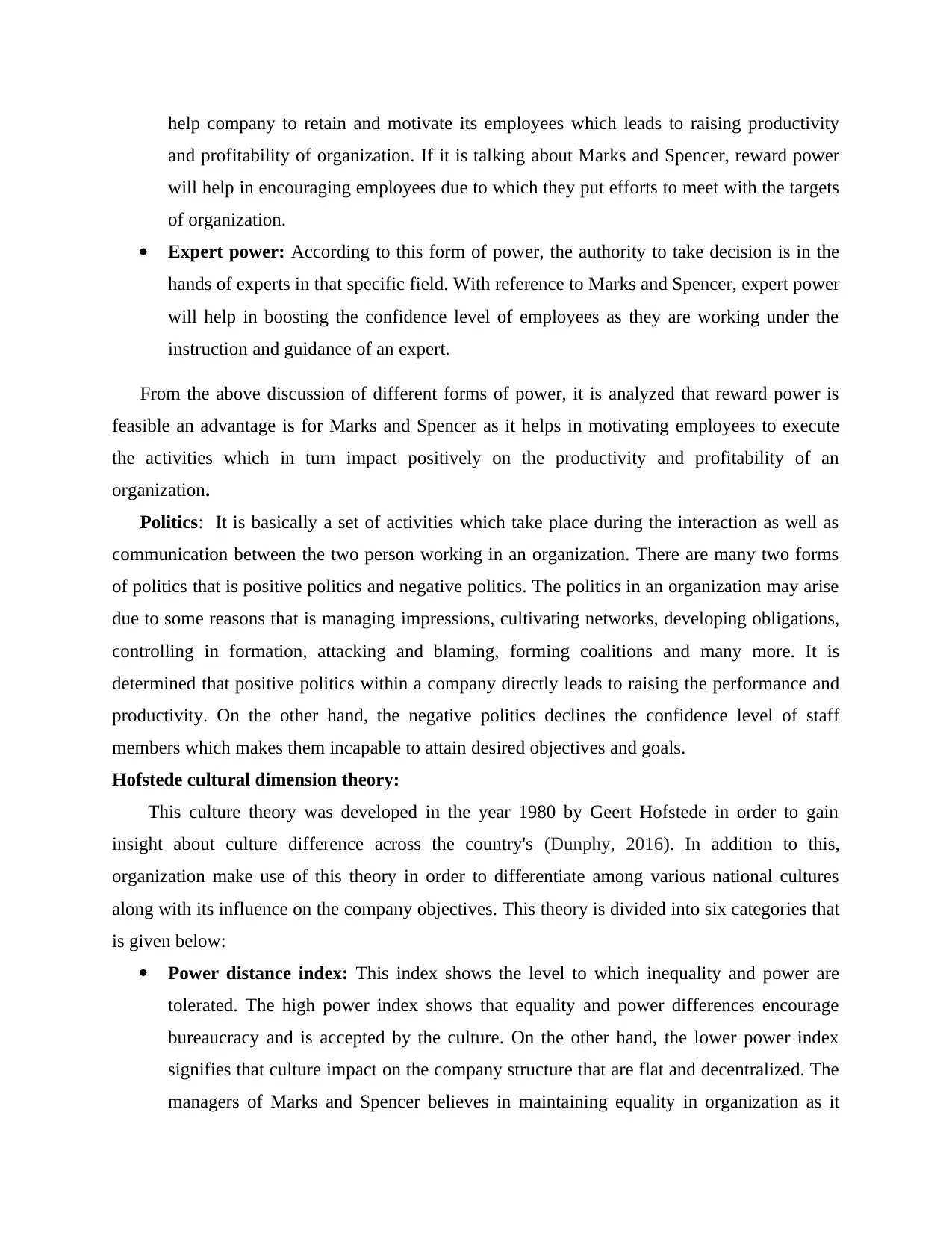
help company to retain and motivate its employees which leads to raising productivity
and profitability of organization. If it is talking about Marks and Spencer, reward power
will help in encouraging employees due to which they put efforts to meet with the targets
of organization.
Expert power: According to this form of power, the authority to take decision is in the
hands of experts in that specific field. With reference to Marks and Spencer, expert power
will help in boosting the confidence level of employees as they are working under the
instruction and guidance of an expert.
From the above discussion of different forms of power, it is analyzed that reward power is
feasible an advantage is for Marks and Spencer as it helps in motivating employees to execute
the activities which in turn impact positively on the productivity and profitability of an
organization.
Politics: It is basically a set of activities which take place during the interaction as well as
communication between the two person working in an organization. There are many two forms
of politics that is positive politics and negative politics. The politics in an organization may arise
due to some reasons that is managing impressions, cultivating networks, developing obligations,
controlling in formation, attacking and blaming, forming coalitions and many more. It is
determined that positive politics within a company directly leads to raising the performance and
productivity. On the other hand, the negative politics declines the confidence level of staff
members which makes them incapable to attain desired objectives and goals.
Hofstede cultural dimension theory:
This culture theory was developed in the year 1980 by Geert Hofstede in order to gain
insight about culture difference across the country's (Dunphy, 2016). In addition to this,
organization make use of this theory in order to differentiate among various national cultures
along with its influence on the company objectives. This theory is divided into six categories that
is given below:
Power distance index: This index shows the level to which inequality and power are
tolerated. The high power index shows that equality and power differences encourage
bureaucracy and is accepted by the culture. On the other hand, the lower power index
signifies that culture impact on the company structure that are flat and decentralized. The
managers of Marks and Spencer believes in maintaining equality in organization as it
and profitability of organization. If it is talking about Marks and Spencer, reward power
will help in encouraging employees due to which they put efforts to meet with the targets
of organization.
Expert power: According to this form of power, the authority to take decision is in the
hands of experts in that specific field. With reference to Marks and Spencer, expert power
will help in boosting the confidence level of employees as they are working under the
instruction and guidance of an expert.
From the above discussion of different forms of power, it is analyzed that reward power is
feasible an advantage is for Marks and Spencer as it helps in motivating employees to execute
the activities which in turn impact positively on the productivity and profitability of an
organization.
Politics: It is basically a set of activities which take place during the interaction as well as
communication between the two person working in an organization. There are many two forms
of politics that is positive politics and negative politics. The politics in an organization may arise
due to some reasons that is managing impressions, cultivating networks, developing obligations,
controlling in formation, attacking and blaming, forming coalitions and many more. It is
determined that positive politics within a company directly leads to raising the performance and
productivity. On the other hand, the negative politics declines the confidence level of staff
members which makes them incapable to attain desired objectives and goals.
Hofstede cultural dimension theory:
This culture theory was developed in the year 1980 by Geert Hofstede in order to gain
insight about culture difference across the country's (Dunphy, 2016). In addition to this,
organization make use of this theory in order to differentiate among various national cultures
along with its influence on the company objectives. This theory is divided into six categories that
is given below:
Power distance index: This index shows the level to which inequality and power are
tolerated. The high power index shows that equality and power differences encourage
bureaucracy and is accepted by the culture. On the other hand, the lower power index
signifies that culture impact on the company structure that are flat and decentralized. The
managers of Marks and Spencer believes in maintaining equality in organization as it
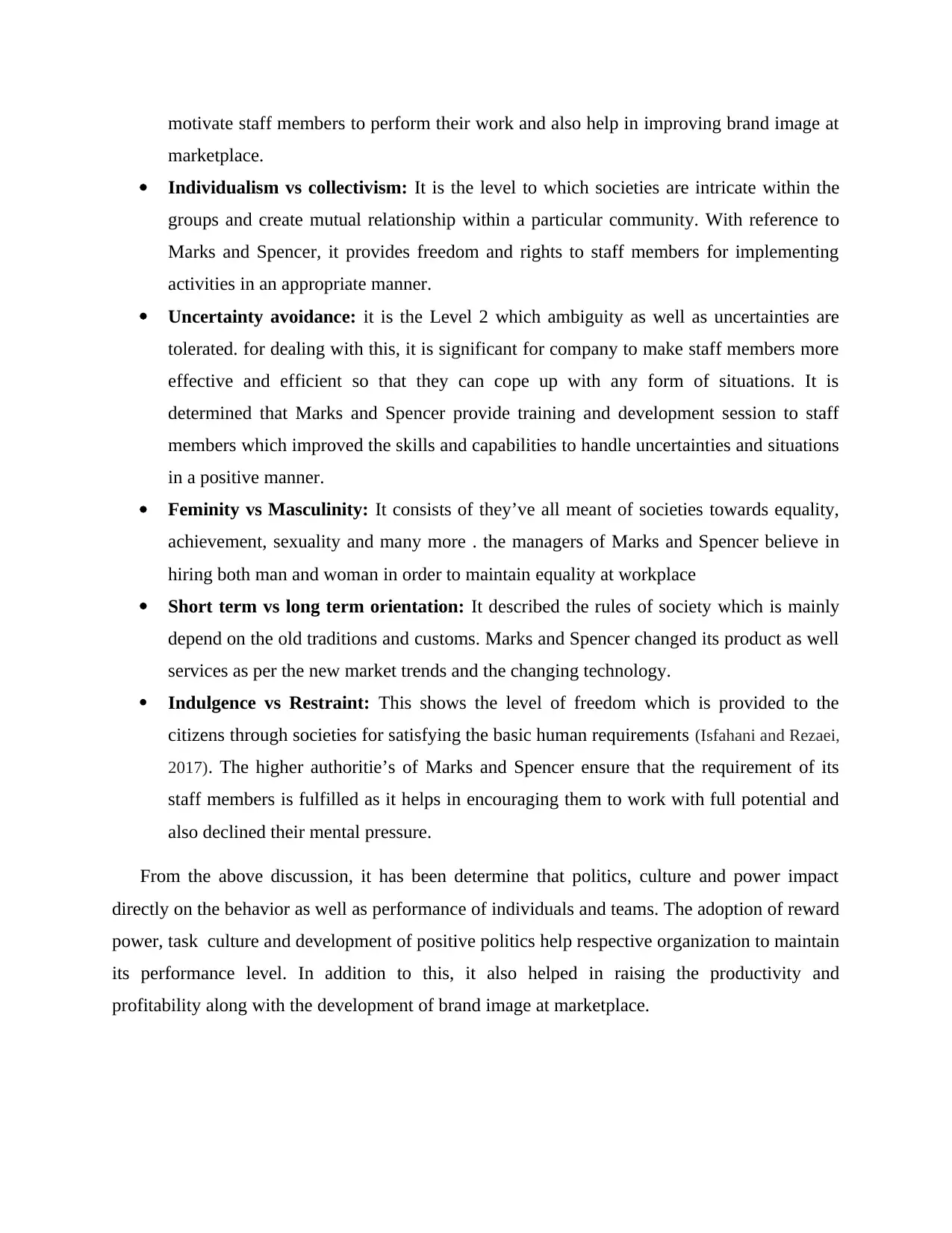
motivate staff members to perform their work and also help in improving brand image at
marketplace.
Individualism vs collectivism: It is the level to which societies are intricate within the
groups and create mutual relationship within a particular community. With reference to
Marks and Spencer, it provides freedom and rights to staff members for implementing
activities in an appropriate manner.
Uncertainty avoidance: it is the Level 2 which ambiguity as well as uncertainties are
tolerated. for dealing with this, it is significant for company to make staff members more
effective and efficient so that they can cope up with any form of situations. It is
determined that Marks and Spencer provide training and development session to staff
members which improved the skills and capabilities to handle uncertainties and situations
in a positive manner.
Feminity vs Masculinity: It consists of they’ve all meant of societies towards equality,
achievement, sexuality and many more . the managers of Marks and Spencer believe in
hiring both man and woman in order to maintain equality at workplace
Short term vs long term orientation: It described the rules of society which is mainly
depend on the old traditions and customs. Marks and Spencer changed its product as well
services as per the new market trends and the changing technology.
Indulgence vs Restraint: This shows the level of freedom which is provided to the
citizens through societies for satisfying the basic human requirements (Isfahani and Rezaei,
2017). The higher authoritie’s of Marks and Spencer ensure that the requirement of its
staff members is fulfilled as it helps in encouraging them to work with full potential and
also declined their mental pressure.
From the above discussion, it has been determine that politics, culture and power impact
directly on the behavior as well as performance of individuals and teams. The adoption of reward
power, task culture and development of positive politics help respective organization to maintain
its performance level. In addition to this, it also helped in raising the productivity and
profitability along with the development of brand image at marketplace.
marketplace.
Individualism vs collectivism: It is the level to which societies are intricate within the
groups and create mutual relationship within a particular community. With reference to
Marks and Spencer, it provides freedom and rights to staff members for implementing
activities in an appropriate manner.
Uncertainty avoidance: it is the Level 2 which ambiguity as well as uncertainties are
tolerated. for dealing with this, it is significant for company to make staff members more
effective and efficient so that they can cope up with any form of situations. It is
determined that Marks and Spencer provide training and development session to staff
members which improved the skills and capabilities to handle uncertainties and situations
in a positive manner.
Feminity vs Masculinity: It consists of they’ve all meant of societies towards equality,
achievement, sexuality and many more . the managers of Marks and Spencer believe in
hiring both man and woman in order to maintain equality at workplace
Short term vs long term orientation: It described the rules of society which is mainly
depend on the old traditions and customs. Marks and Spencer changed its product as well
services as per the new market trends and the changing technology.
Indulgence vs Restraint: This shows the level of freedom which is provided to the
citizens through societies for satisfying the basic human requirements (Isfahani and Rezaei,
2017). The higher authoritie’s of Marks and Spencer ensure that the requirement of its
staff members is fulfilled as it helps in encouraging them to work with full potential and
also declined their mental pressure.
From the above discussion, it has been determine that politics, culture and power impact
directly on the behavior as well as performance of individuals and teams. The adoption of reward
power, task culture and development of positive politics help respective organization to maintain
its performance level. In addition to this, it also helped in raising the productivity and
profitability along with the development of brand image at marketplace.
Paraphrase This Document
Need a fresh take? Get an instant paraphrase of this document with our AI Paraphraser
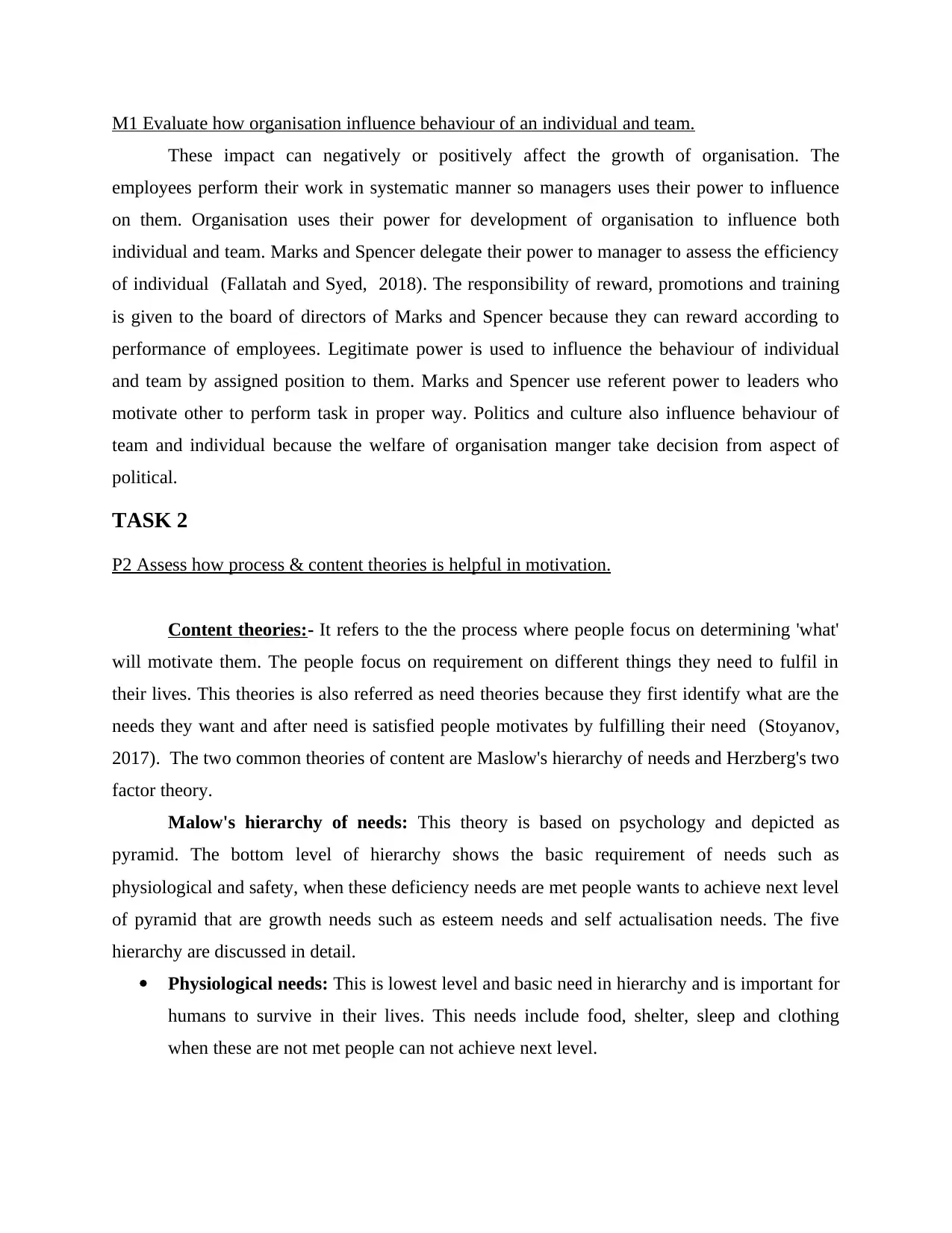
M1 Evaluate how organisation influence behaviour of an individual and team.
These impact can negatively or positively affect the growth of organisation. The
employees perform their work in systematic manner so managers uses their power to influence
on them. Organisation uses their power for development of organisation to influence both
individual and team. Marks and Spencer delegate their power to manager to assess the efficiency
of individual (Fallatah and Syed, 2018). The responsibility of reward, promotions and training
is given to the board of directors of Marks and Spencer because they can reward according to
performance of employees. Legitimate power is used to influence the behaviour of individual
and team by assigned position to them. Marks and Spencer use referent power to leaders who
motivate other to perform task in proper way. Politics and culture also influence behaviour of
team and individual because the welfare of organisation manger take decision from aspect of
political.
TASK 2
P2 Assess how process & content theories is helpful in motivation.
Content theories:- It refers to the the process where people focus on determining 'what'
will motivate them. The people focus on requirement on different things they need to fulfil in
their lives. This theories is also referred as need theories because they first identify what are the
needs they want and after need is satisfied people motivates by fulfilling their need (Stoyanov,
2017). The two common theories of content are Maslow's hierarchy of needs and Herzberg's two
factor theory.
Malow's hierarchy of needs: This theory is based on psychology and depicted as
pyramid. The bottom level of hierarchy shows the basic requirement of needs such as
physiological and safety, when these deficiency needs are met people wants to achieve next level
of pyramid that are growth needs such as esteem needs and self actualisation needs. The five
hierarchy are discussed in detail.
Physiological needs: This is lowest level and basic need in hierarchy and is important for
humans to survive in their lives. This needs include food, shelter, sleep and clothing
when these are not met people can not achieve next level.
These impact can negatively or positively affect the growth of organisation. The
employees perform their work in systematic manner so managers uses their power to influence
on them. Organisation uses their power for development of organisation to influence both
individual and team. Marks and Spencer delegate their power to manager to assess the efficiency
of individual (Fallatah and Syed, 2018). The responsibility of reward, promotions and training
is given to the board of directors of Marks and Spencer because they can reward according to
performance of employees. Legitimate power is used to influence the behaviour of individual
and team by assigned position to them. Marks and Spencer use referent power to leaders who
motivate other to perform task in proper way. Politics and culture also influence behaviour of
team and individual because the welfare of organisation manger take decision from aspect of
political.
TASK 2
P2 Assess how process & content theories is helpful in motivation.
Content theories:- It refers to the the process where people focus on determining 'what'
will motivate them. The people focus on requirement on different things they need to fulfil in
their lives. This theories is also referred as need theories because they first identify what are the
needs they want and after need is satisfied people motivates by fulfilling their need (Stoyanov,
2017). The two common theories of content are Maslow's hierarchy of needs and Herzberg's two
factor theory.
Malow's hierarchy of needs: This theory is based on psychology and depicted as
pyramid. The bottom level of hierarchy shows the basic requirement of needs such as
physiological and safety, when these deficiency needs are met people wants to achieve next level
of pyramid that are growth needs such as esteem needs and self actualisation needs. The five
hierarchy are discussed in detail.
Physiological needs: This is lowest level and basic need in hierarchy and is important for
humans to survive in their lives. This needs include food, shelter, sleep and clothing
when these are not met people can not achieve next level.
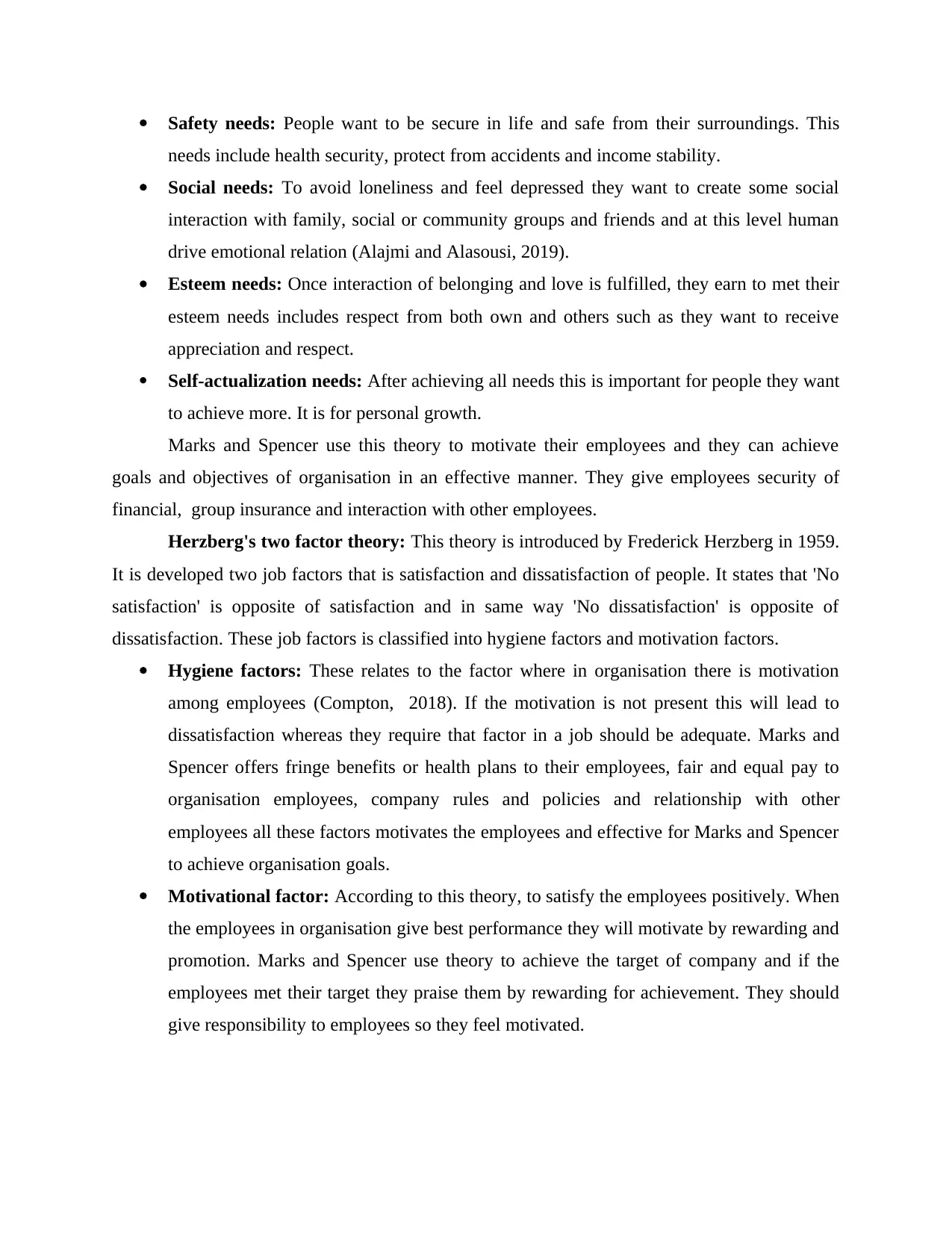
Safety needs: People want to be secure in life and safe from their surroundings. This
needs include health security, protect from accidents and income stability.
Social needs: To avoid loneliness and feel depressed they want to create some social
interaction with family, social or community groups and friends and at this level human
drive emotional relation (Alajmi and Alasousi, 2019).
Esteem needs: Once interaction of belonging and love is fulfilled, they earn to met their
esteem needs includes respect from both own and others such as they want to receive
appreciation and respect.
Self-actualization needs: After achieving all needs this is important for people they want
to achieve more. It is for personal growth.
Marks and Spencer use this theory to motivate their employees and they can achieve
goals and objectives of organisation in an effective manner. They give employees security of
financial, group insurance and interaction with other employees.
Herzberg's two factor theory: This theory is introduced by Frederick Herzberg in 1959.
It is developed two job factors that is satisfaction and dissatisfaction of people. It states that 'No
satisfaction' is opposite of satisfaction and in same way 'No dissatisfaction' is opposite of
dissatisfaction. These job factors is classified into hygiene factors and motivation factors.
Hygiene factors: These relates to the factor where in organisation there is motivation
among employees (Compton, 2018). If the motivation is not present this will lead to
dissatisfaction whereas they require that factor in a job should be adequate. Marks and
Spencer offers fringe benefits or health plans to their employees, fair and equal pay to
organisation employees, company rules and policies and relationship with other
employees all these factors motivates the employees and effective for Marks and Spencer
to achieve organisation goals.
Motivational factor: According to this theory, to satisfy the employees positively. When
the employees in organisation give best performance they will motivate by rewarding and
promotion. Marks and Spencer use theory to achieve the target of company and if the
employees met their target they praise them by rewarding for achievement. They should
give responsibility to employees so they feel motivated.
needs include health security, protect from accidents and income stability.
Social needs: To avoid loneliness and feel depressed they want to create some social
interaction with family, social or community groups and friends and at this level human
drive emotional relation (Alajmi and Alasousi, 2019).
Esteem needs: Once interaction of belonging and love is fulfilled, they earn to met their
esteem needs includes respect from both own and others such as they want to receive
appreciation and respect.
Self-actualization needs: After achieving all needs this is important for people they want
to achieve more. It is for personal growth.
Marks and Spencer use this theory to motivate their employees and they can achieve
goals and objectives of organisation in an effective manner. They give employees security of
financial, group insurance and interaction with other employees.
Herzberg's two factor theory: This theory is introduced by Frederick Herzberg in 1959.
It is developed two job factors that is satisfaction and dissatisfaction of people. It states that 'No
satisfaction' is opposite of satisfaction and in same way 'No dissatisfaction' is opposite of
dissatisfaction. These job factors is classified into hygiene factors and motivation factors.
Hygiene factors: These relates to the factor where in organisation there is motivation
among employees (Compton, 2018). If the motivation is not present this will lead to
dissatisfaction whereas they require that factor in a job should be adequate. Marks and
Spencer offers fringe benefits or health plans to their employees, fair and equal pay to
organisation employees, company rules and policies and relationship with other
employees all these factors motivates the employees and effective for Marks and Spencer
to achieve organisation goals.
Motivational factor: According to this theory, to satisfy the employees positively. When
the employees in organisation give best performance they will motivate by rewarding and
promotion. Marks and Spencer use theory to achieve the target of company and if the
employees met their target they praise them by rewarding for achievement. They should
give responsibility to employees so they feel motivated.
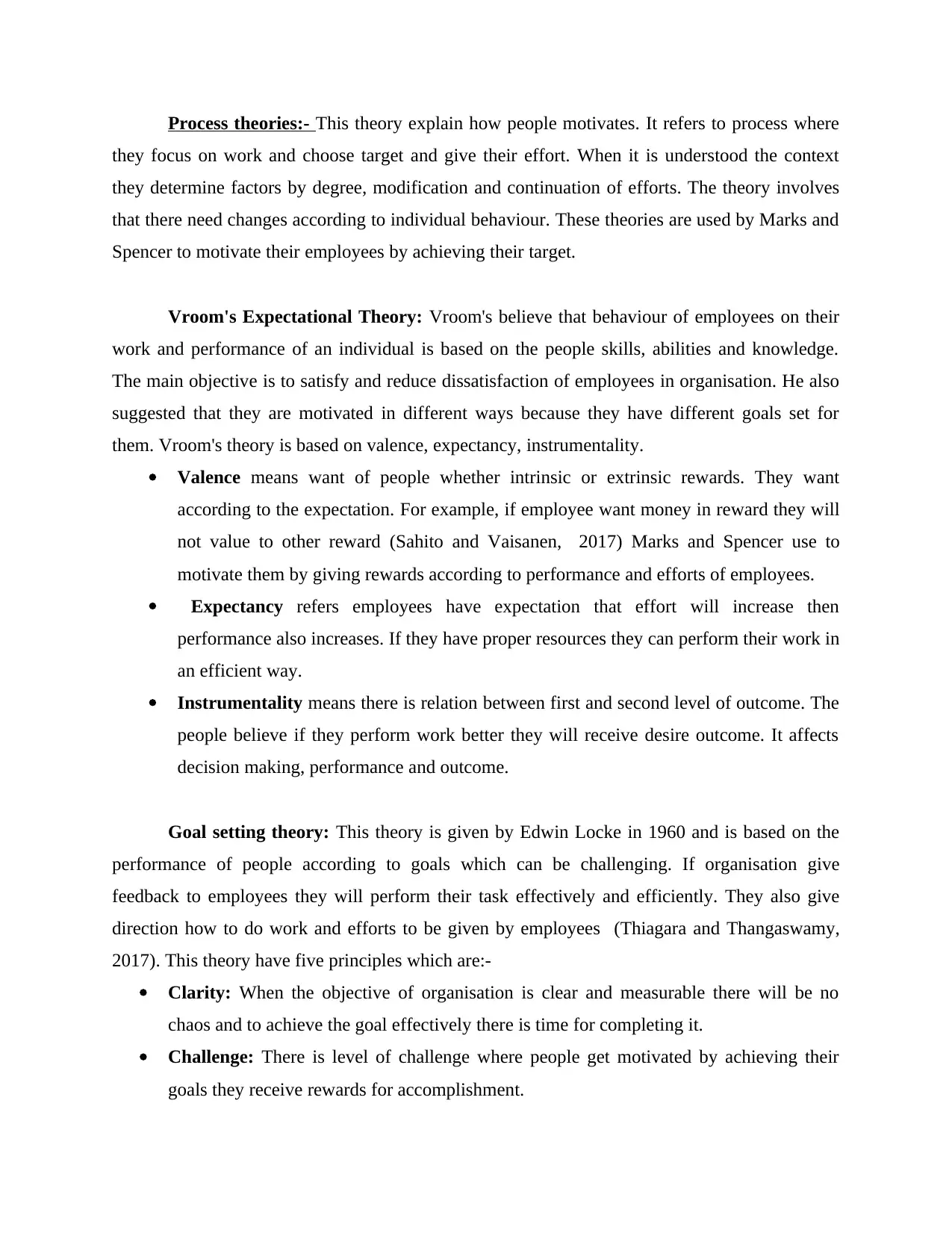
Process theories:- This theory explain how people motivates. It refers to process where
they focus on work and choose target and give their effort. When it is understood the context
they determine factors by degree, modification and continuation of efforts. The theory involves
that there need changes according to individual behaviour. These theories are used by Marks and
Spencer to motivate their employees by achieving their target.
Vroom's Expectational Theory: Vroom's believe that behaviour of employees on their
work and performance of an individual is based on the people skills, abilities and knowledge.
The main objective is to satisfy and reduce dissatisfaction of employees in organisation. He also
suggested that they are motivated in different ways because they have different goals set for
them. Vroom's theory is based on valence, expectancy, instrumentality.
Valence means want of people whether intrinsic or extrinsic rewards. They want
according to the expectation. For example, if employee want money in reward they will
not value to other reward (Sahito and Vaisanen, 2017) Marks and Spencer use to
motivate them by giving rewards according to performance and efforts of employees.
Expectancy refers employees have expectation that effort will increase then
performance also increases. If they have proper resources they can perform their work in
an efficient way.
Instrumentality means there is relation between first and second level of outcome. The
people believe if they perform work better they will receive desire outcome. It affects
decision making, performance and outcome.
Goal setting theory: This theory is given by Edwin Locke in 1960 and is based on the
performance of people according to goals which can be challenging. If organisation give
feedback to employees they will perform their task effectively and efficiently. They also give
direction how to do work and efforts to be given by employees (Thiagara and Thangaswamy,
2017). This theory have five principles which are:-
Clarity: When the objective of organisation is clear and measurable there will be no
chaos and to achieve the goal effectively there is time for completing it.
Challenge: There is level of challenge where people get motivated by achieving their
goals they receive rewards for accomplishment.
they focus on work and choose target and give their effort. When it is understood the context
they determine factors by degree, modification and continuation of efforts. The theory involves
that there need changes according to individual behaviour. These theories are used by Marks and
Spencer to motivate their employees by achieving their target.
Vroom's Expectational Theory: Vroom's believe that behaviour of employees on their
work and performance of an individual is based on the people skills, abilities and knowledge.
The main objective is to satisfy and reduce dissatisfaction of employees in organisation. He also
suggested that they are motivated in different ways because they have different goals set for
them. Vroom's theory is based on valence, expectancy, instrumentality.
Valence means want of people whether intrinsic or extrinsic rewards. They want
according to the expectation. For example, if employee want money in reward they will
not value to other reward (Sahito and Vaisanen, 2017) Marks and Spencer use to
motivate them by giving rewards according to performance and efforts of employees.
Expectancy refers employees have expectation that effort will increase then
performance also increases. If they have proper resources they can perform their work in
an efficient way.
Instrumentality means there is relation between first and second level of outcome. The
people believe if they perform work better they will receive desire outcome. It affects
decision making, performance and outcome.
Goal setting theory: This theory is given by Edwin Locke in 1960 and is based on the
performance of people according to goals which can be challenging. If organisation give
feedback to employees they will perform their task effectively and efficiently. They also give
direction how to do work and efforts to be given by employees (Thiagara and Thangaswamy,
2017). This theory have five principles which are:-
Clarity: When the objective of organisation is clear and measurable there will be no
chaos and to achieve the goal effectively there is time for completing it.
Challenge: There is level of challenge where people get motivated by achieving their
goals they receive rewards for accomplishment.
Secure Best Marks with AI Grader
Need help grading? Try our AI Grader for instant feedback on your assignments.
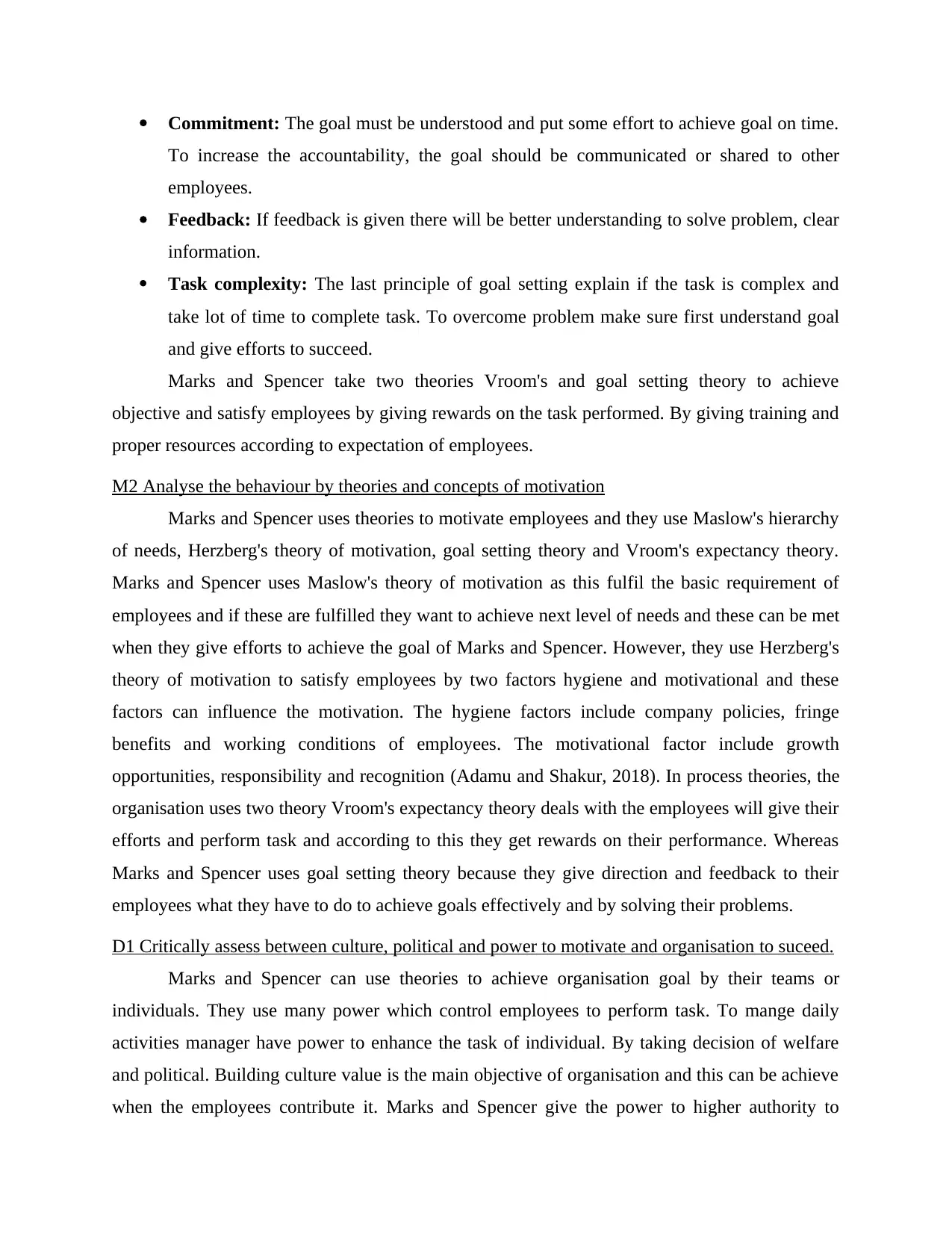
Commitment: The goal must be understood and put some effort to achieve goal on time.
To increase the accountability, the goal should be communicated or shared to other
employees.
Feedback: If feedback is given there will be better understanding to solve problem, clear
information.
Task complexity: The last principle of goal setting explain if the task is complex and
take lot of time to complete task. To overcome problem make sure first understand goal
and give efforts to succeed.
Marks and Spencer take two theories Vroom's and goal setting theory to achieve
objective and satisfy employees by giving rewards on the task performed. By giving training and
proper resources according to expectation of employees.
M2 Analyse the behaviour by theories and concepts of motivation
Marks and Spencer uses theories to motivate employees and they use Maslow's hierarchy
of needs, Herzberg's theory of motivation, goal setting theory and Vroom's expectancy theory.
Marks and Spencer uses Maslow's theory of motivation as this fulfil the basic requirement of
employees and if these are fulfilled they want to achieve next level of needs and these can be met
when they give efforts to achieve the goal of Marks and Spencer. However, they use Herzberg's
theory of motivation to satisfy employees by two factors hygiene and motivational and these
factors can influence the motivation. The hygiene factors include company policies, fringe
benefits and working conditions of employees. The motivational factor include growth
opportunities, responsibility and recognition (Adamu and Shakur, 2018). In process theories, the
organisation uses two theory Vroom's expectancy theory deals with the employees will give their
efforts and perform task and according to this they get rewards on their performance. Whereas
Marks and Spencer uses goal setting theory because they give direction and feedback to their
employees what they have to do to achieve goals effectively and by solving their problems.
D1 Critically assess between culture, political and power to motivate and organisation to suceed.
Marks and Spencer can use theories to achieve organisation goal by their teams or
individuals. They use many power which control employees to perform task. To mange daily
activities manager have power to enhance the task of individual. By taking decision of welfare
and political. Building culture value is the main objective of organisation and this can be achieve
when the employees contribute it. Marks and Spencer give the power to higher authority to
To increase the accountability, the goal should be communicated or shared to other
employees.
Feedback: If feedback is given there will be better understanding to solve problem, clear
information.
Task complexity: The last principle of goal setting explain if the task is complex and
take lot of time to complete task. To overcome problem make sure first understand goal
and give efforts to succeed.
Marks and Spencer take two theories Vroom's and goal setting theory to achieve
objective and satisfy employees by giving rewards on the task performed. By giving training and
proper resources according to expectation of employees.
M2 Analyse the behaviour by theories and concepts of motivation
Marks and Spencer uses theories to motivate employees and they use Maslow's hierarchy
of needs, Herzberg's theory of motivation, goal setting theory and Vroom's expectancy theory.
Marks and Spencer uses Maslow's theory of motivation as this fulfil the basic requirement of
employees and if these are fulfilled they want to achieve next level of needs and these can be met
when they give efforts to achieve the goal of Marks and Spencer. However, they use Herzberg's
theory of motivation to satisfy employees by two factors hygiene and motivational and these
factors can influence the motivation. The hygiene factors include company policies, fringe
benefits and working conditions of employees. The motivational factor include growth
opportunities, responsibility and recognition (Adamu and Shakur, 2018). In process theories, the
organisation uses two theory Vroom's expectancy theory deals with the employees will give their
efforts and perform task and according to this they get rewards on their performance. Whereas
Marks and Spencer uses goal setting theory because they give direction and feedback to their
employees what they have to do to achieve goals effectively and by solving their problems.
D1 Critically assess between culture, political and power to motivate and organisation to suceed.
Marks and Spencer can use theories to achieve organisation goal by their teams or
individuals. They use many power which control employees to perform task. To mange daily
activities manager have power to enhance the task of individual. By taking decision of welfare
and political. Building culture value is the main objective of organisation and this can be achieve
when the employees contribute it. Marks and Spencer give the power to higher authority to
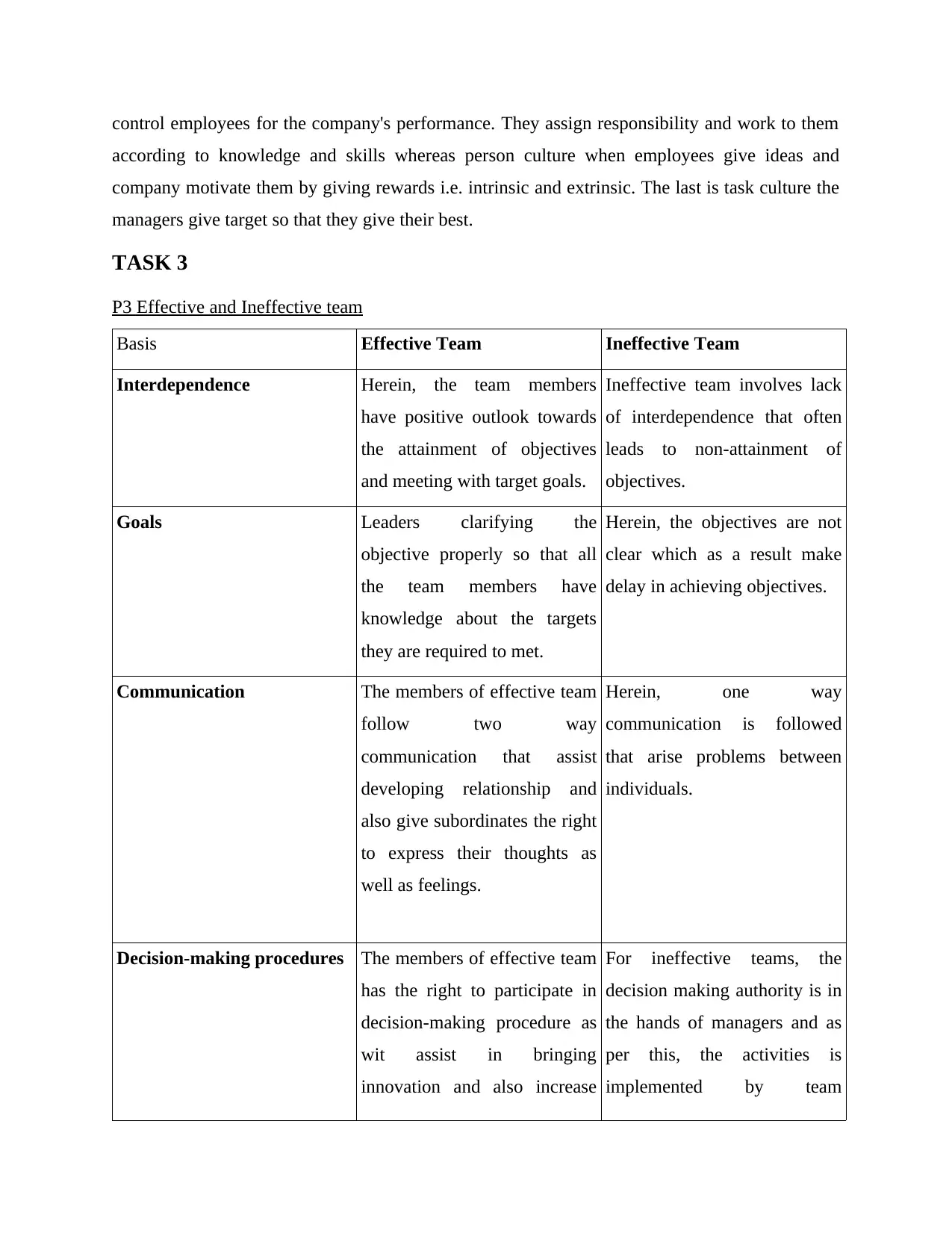
control employees for the company's performance. They assign responsibility and work to them
according to knowledge and skills whereas person culture when employees give ideas and
company motivate them by giving rewards i.e. intrinsic and extrinsic. The last is task culture the
managers give target so that they give their best.
TASK 3
P3 Effective and Ineffective team
Basis Effective Team Ineffective Team
Interdependence Herein, the team members
have positive outlook towards
the attainment of objectives
and meeting with target goals.
Ineffective team involves lack
of interdependence that often
leads to non-attainment of
objectives.
Goals Leaders clarifying the
objective properly so that all
the team members have
knowledge about the targets
they are required to met.
Herein, the objectives are not
clear which as a result make
delay in achieving objectives.
Communication The members of effective team
follow two way
communication that assist
developing relationship and
also give subordinates the right
to express their thoughts as
well as feelings.
Herein, one way
communication is followed
that arise problems between
individuals.
Decision-making procedures The members of effective team
has the right to participate in
decision-making procedure as
wit assist in bringing
innovation and also increase
For ineffective teams, the
decision making authority is in
the hands of managers and as
per this, the activities is
implemented by team
according to knowledge and skills whereas person culture when employees give ideas and
company motivate them by giving rewards i.e. intrinsic and extrinsic. The last is task culture the
managers give target so that they give their best.
TASK 3
P3 Effective and Ineffective team
Basis Effective Team Ineffective Team
Interdependence Herein, the team members
have positive outlook towards
the attainment of objectives
and meeting with target goals.
Ineffective team involves lack
of interdependence that often
leads to non-attainment of
objectives.
Goals Leaders clarifying the
objective properly so that all
the team members have
knowledge about the targets
they are required to met.
Herein, the objectives are not
clear which as a result make
delay in achieving objectives.
Communication The members of effective team
follow two way
communication that assist
developing relationship and
also give subordinates the right
to express their thoughts as
well as feelings.
Herein, one way
communication is followed
that arise problems between
individuals.
Decision-making procedures The members of effective team
has the right to participate in
decision-making procedure as
wit assist in bringing
innovation and also increase
For ineffective teams, the
decision making authority is in
the hands of managers and as
per this, the activities is
implemented by team
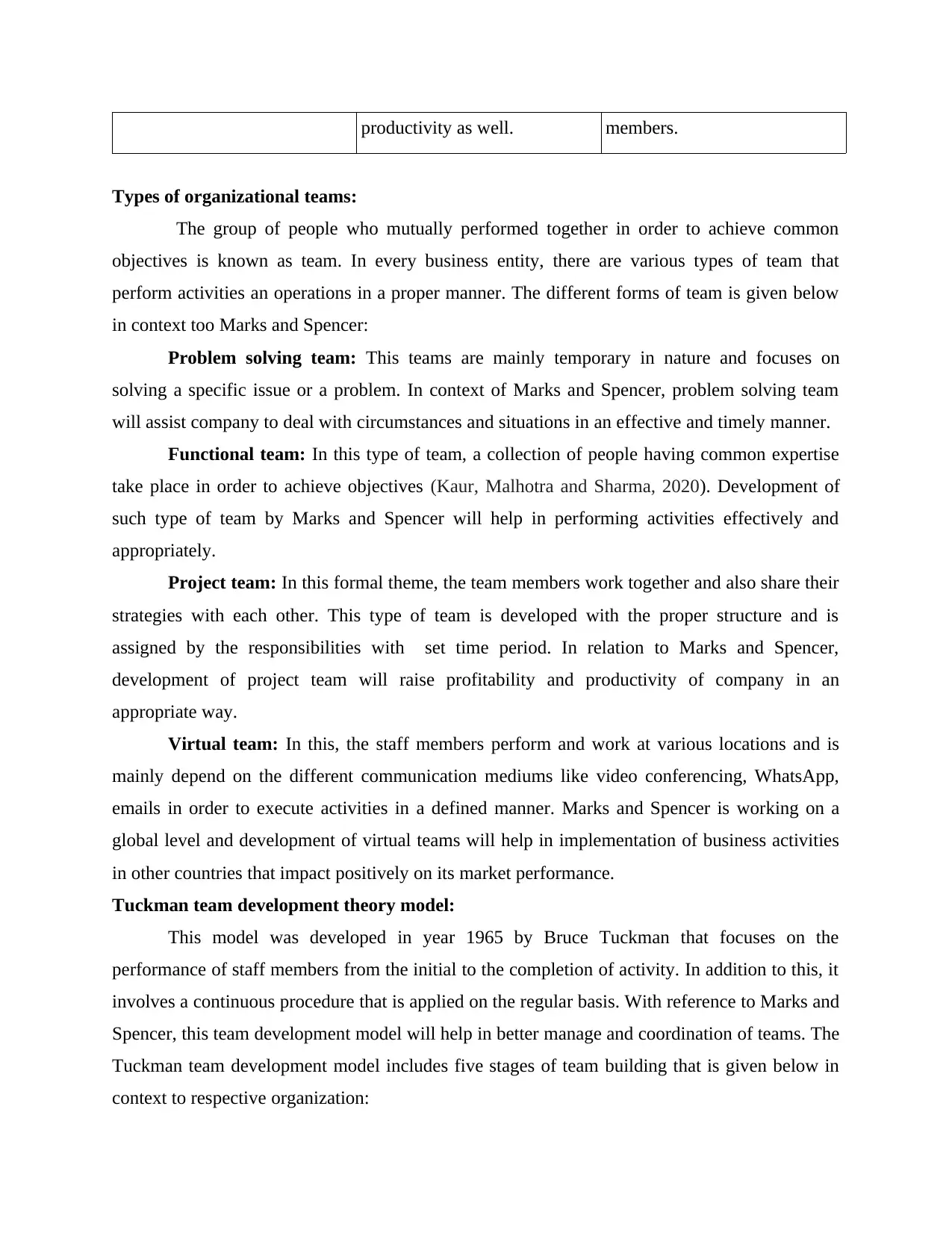
productivity as well. members.
Types of organizational teams:
The group of people who mutually performed together in order to achieve common
objectives is known as team. In every business entity, there are various types of team that
perform activities an operations in a proper manner. The different forms of team is given below
in context too Marks and Spencer:
Problem solving team: This teams are mainly temporary in nature and focuses on
solving a specific issue or a problem. In context of Marks and Spencer, problem solving team
will assist company to deal with circumstances and situations in an effective and timely manner.
Functional team: In this type of team, a collection of people having common expertise
take place in order to achieve objectives (Kaur, Malhotra and Sharma, 2020). Development of
such type of team by Marks and Spencer will help in performing activities effectively and
appropriately.
Project team: In this formal theme, the team members work together and also share their
strategies with each other. This type of team is developed with the proper structure and is
assigned by the responsibilities with set time period. In relation to Marks and Spencer,
development of project team will raise profitability and productivity of company in an
appropriate way.
Virtual team: In this, the staff members perform and work at various locations and is
mainly depend on the different communication mediums like video conferencing, WhatsApp,
emails in order to execute activities in a defined manner. Marks and Spencer is working on a
global level and development of virtual teams will help in implementation of business activities
in other countries that impact positively on its market performance.
Tuckman team development theory model:
This model was developed in year 1965 by Bruce Tuckman that focuses on the
performance of staff members from the initial to the completion of activity. In addition to this, it
involves a continuous procedure that is applied on the regular basis. With reference to Marks and
Spencer, this team development model will help in better manage and coordination of teams. The
Tuckman team development model includes five stages of team building that is given below in
context to respective organization:
Types of organizational teams:
The group of people who mutually performed together in order to achieve common
objectives is known as team. In every business entity, there are various types of team that
perform activities an operations in a proper manner. The different forms of team is given below
in context too Marks and Spencer:
Problem solving team: This teams are mainly temporary in nature and focuses on
solving a specific issue or a problem. In context of Marks and Spencer, problem solving team
will assist company to deal with circumstances and situations in an effective and timely manner.
Functional team: In this type of team, a collection of people having common expertise
take place in order to achieve objectives (Kaur, Malhotra and Sharma, 2020). Development of
such type of team by Marks and Spencer will help in performing activities effectively and
appropriately.
Project team: In this formal theme, the team members work together and also share their
strategies with each other. This type of team is developed with the proper structure and is
assigned by the responsibilities with set time period. In relation to Marks and Spencer,
development of project team will raise profitability and productivity of company in an
appropriate way.
Virtual team: In this, the staff members perform and work at various locations and is
mainly depend on the different communication mediums like video conferencing, WhatsApp,
emails in order to execute activities in a defined manner. Marks and Spencer is working on a
global level and development of virtual teams will help in implementation of business activities
in other countries that impact positively on its market performance.
Tuckman team development theory model:
This model was developed in year 1965 by Bruce Tuckman that focuses on the
performance of staff members from the initial to the completion of activity. In addition to this, it
involves a continuous procedure that is applied on the regular basis. With reference to Marks and
Spencer, this team development model will help in better manage and coordination of teams. The
Tuckman team development model includes five stages of team building that is given below in
context to respective organization:
Paraphrase This Document
Need a fresh take? Get an instant paraphrase of this document with our AI Paraphraser
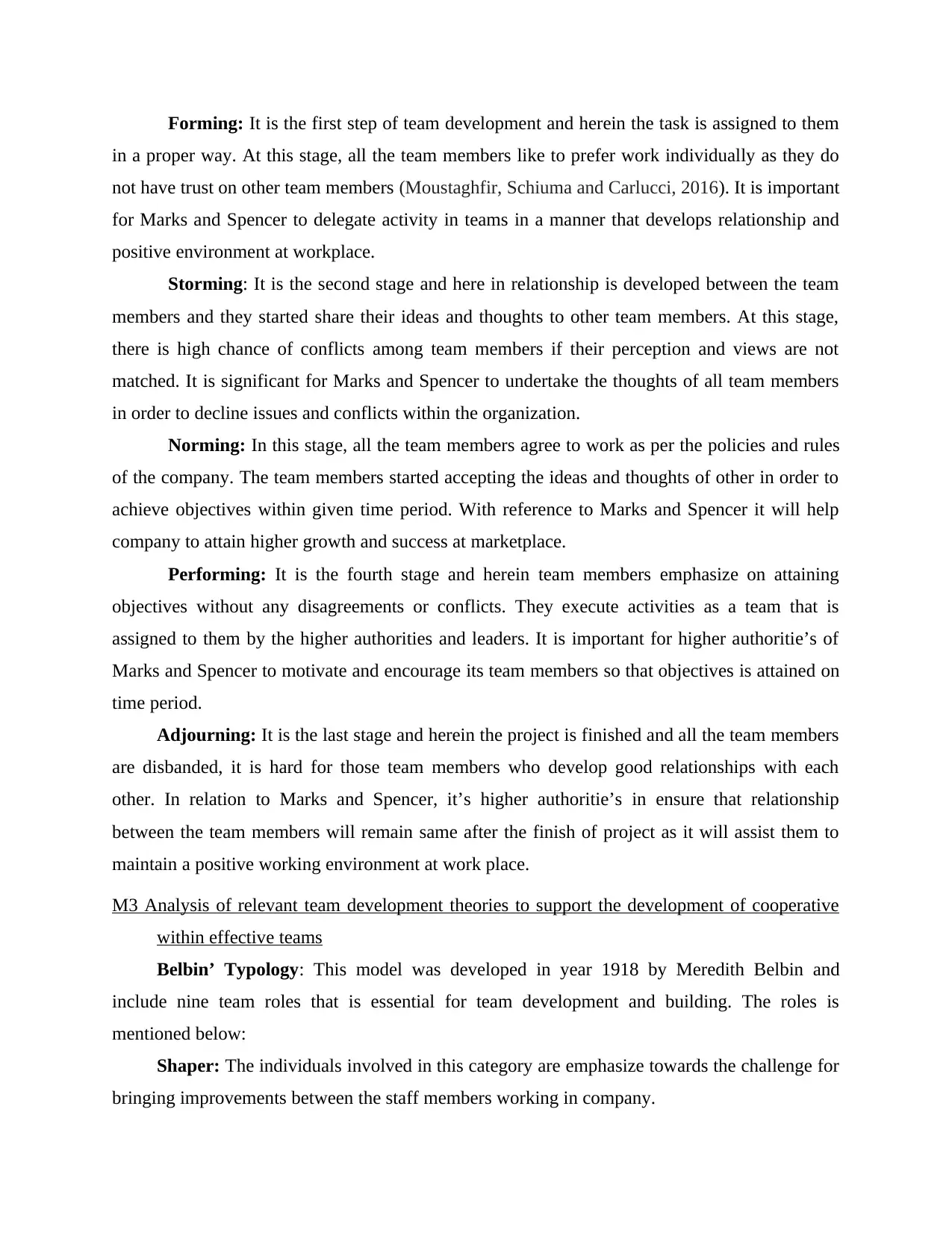
Forming: It is the first step of team development and herein the task is assigned to them
in a proper way. At this stage, all the team members like to prefer work individually as they do
not have trust on other team members (Moustaghfir, Schiuma and Carlucci, 2016). It is important
for Marks and Spencer to delegate activity in teams in a manner that develops relationship and
positive environment at workplace.
Storming: It is the second stage and here in relationship is developed between the team
members and they started share their ideas and thoughts to other team members. At this stage,
there is high chance of conflicts among team members if their perception and views are not
matched. It is significant for Marks and Spencer to undertake the thoughts of all team members
in order to decline issues and conflicts within the organization.
Norming: In this stage, all the team members agree to work as per the policies and rules
of the company. The team members started accepting the ideas and thoughts of other in order to
achieve objectives within given time period. With reference to Marks and Spencer it will help
company to attain higher growth and success at marketplace.
Performing: It is the fourth stage and herein team members emphasize on attaining
objectives without any disagreements or conflicts. They execute activities as a team that is
assigned to them by the higher authorities and leaders. It is important for higher authoritie’s of
Marks and Spencer to motivate and encourage its team members so that objectives is attained on
time period.
Adjourning: It is the last stage and herein the project is finished and all the team members
are disbanded, it is hard for those team members who develop good relationships with each
other. In relation to Marks and Spencer, it’s higher authoritie’s in ensure that relationship
between the team members will remain same after the finish of project as it will assist them to
maintain a positive working environment at work place.
M3 Analysis of relevant team development theories to support the development of cooperative
within effective teams
Belbin’ Typology: This model was developed in year 1918 by Meredith Belbin and
include nine team roles that is essential for team development and building. The roles is
mentioned below:
Shaper: The individuals involved in this category are emphasize towards the challenge for
bringing improvements between the staff members working in company.
in a proper way. At this stage, all the team members like to prefer work individually as they do
not have trust on other team members (Moustaghfir, Schiuma and Carlucci, 2016). It is important
for Marks and Spencer to delegate activity in teams in a manner that develops relationship and
positive environment at workplace.
Storming: It is the second stage and here in relationship is developed between the team
members and they started share their ideas and thoughts to other team members. At this stage,
there is high chance of conflicts among team members if their perception and views are not
matched. It is significant for Marks and Spencer to undertake the thoughts of all team members
in order to decline issues and conflicts within the organization.
Norming: In this stage, all the team members agree to work as per the policies and rules
of the company. The team members started accepting the ideas and thoughts of other in order to
achieve objectives within given time period. With reference to Marks and Spencer it will help
company to attain higher growth and success at marketplace.
Performing: It is the fourth stage and herein team members emphasize on attaining
objectives without any disagreements or conflicts. They execute activities as a team that is
assigned to them by the higher authorities and leaders. It is important for higher authoritie’s of
Marks and Spencer to motivate and encourage its team members so that objectives is attained on
time period.
Adjourning: It is the last stage and herein the project is finished and all the team members
are disbanded, it is hard for those team members who develop good relationships with each
other. In relation to Marks and Spencer, it’s higher authoritie’s in ensure that relationship
between the team members will remain same after the finish of project as it will assist them to
maintain a positive working environment at work place.
M3 Analysis of relevant team development theories to support the development of cooperative
within effective teams
Belbin’ Typology: This model was developed in year 1918 by Meredith Belbin and
include nine team roles that is essential for team development and building. The roles is
mentioned below:
Shaper: The individuals involved in this category are emphasize towards the challenge for
bringing improvements between the staff members working in company.
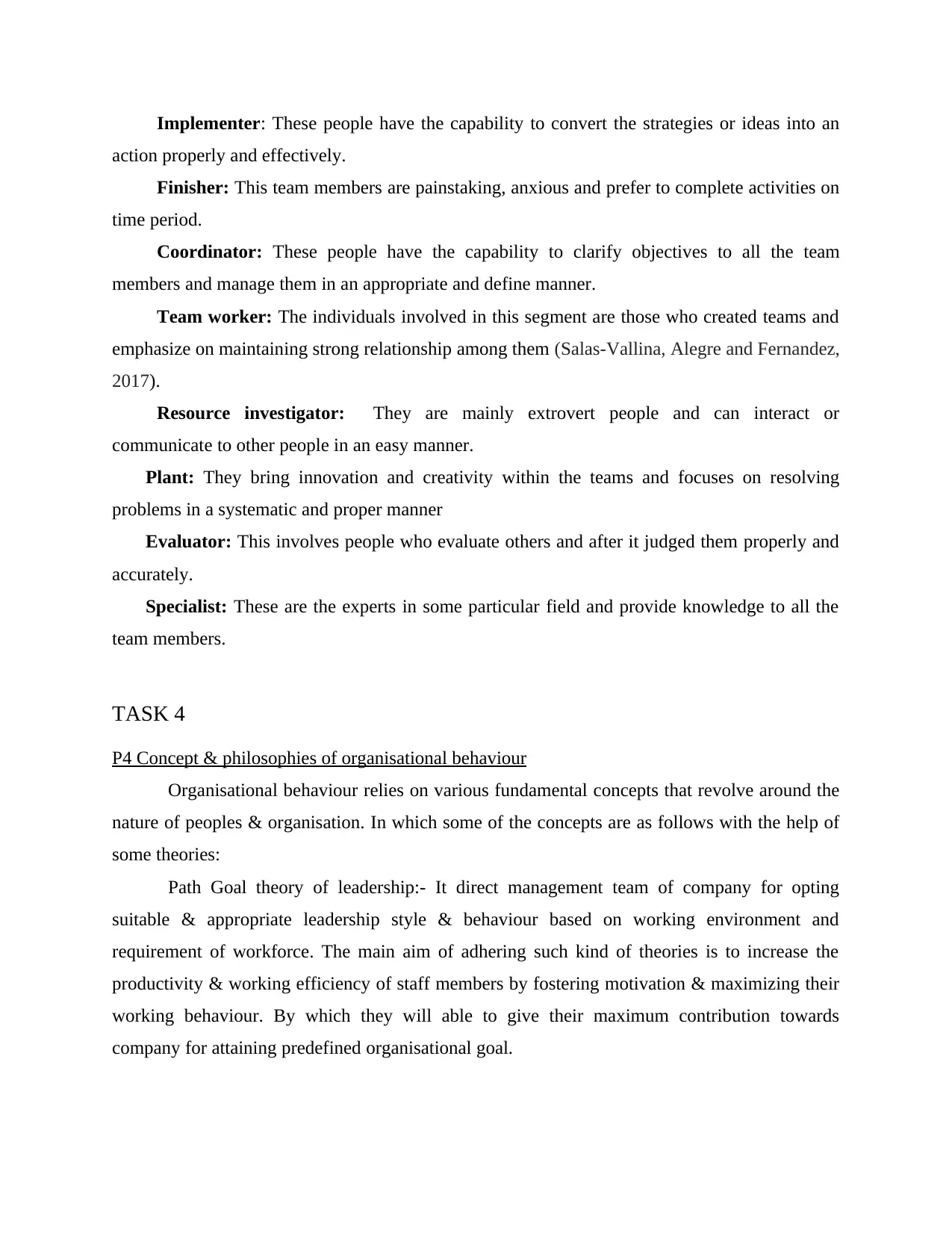
Implementer: These people have the capability to convert the strategies or ideas into an
action properly and effectively.
Finisher: This team members are painstaking, anxious and prefer to complete activities on
time period.
Coordinator: These people have the capability to clarify objectives to all the team
members and manage them in an appropriate and define manner.
Team worker: The individuals involved in this segment are those who created teams and
emphasize on maintaining strong relationship among them (Salas-Vallina, Alegre and Fernandez,
2017).
Resource investigator: They are mainly extrovert people and can interact or
communicate to other people in an easy manner.
Plant: They bring innovation and creativity within the teams and focuses on resolving
problems in a systematic and proper manner
Evaluator: This involves people who evaluate others and after it judged them properly and
accurately.
Specialist: These are the experts in some particular field and provide knowledge to all the
team members.
TASK 4
P4 Concept & philosophies of organisational behaviour
Organisational behaviour relies on various fundamental concepts that revolve around the
nature of peoples & organisation. In which some of the concepts are as follows with the help of
some theories:
Path Goal theory of leadership:- It direct management team of company for opting
suitable & appropriate leadership style & behaviour based on working environment and
requirement of workforce. The main aim of adhering such kind of theories is to increase the
productivity & working efficiency of staff members by fostering motivation & maximizing their
working behaviour. By which they will able to give their maximum contribution towards
company for attaining predefined organisational goal.
action properly and effectively.
Finisher: This team members are painstaking, anxious and prefer to complete activities on
time period.
Coordinator: These people have the capability to clarify objectives to all the team
members and manage them in an appropriate and define manner.
Team worker: The individuals involved in this segment are those who created teams and
emphasize on maintaining strong relationship among them (Salas-Vallina, Alegre and Fernandez,
2017).
Resource investigator: They are mainly extrovert people and can interact or
communicate to other people in an easy manner.
Plant: They bring innovation and creativity within the teams and focuses on resolving
problems in a systematic and proper manner
Evaluator: This involves people who evaluate others and after it judged them properly and
accurately.
Specialist: These are the experts in some particular field and provide knowledge to all the
team members.
TASK 4
P4 Concept & philosophies of organisational behaviour
Organisational behaviour relies on various fundamental concepts that revolve around the
nature of peoples & organisation. In which some of the concepts are as follows with the help of
some theories:
Path Goal theory of leadership:- It direct management team of company for opting
suitable & appropriate leadership style & behaviour based on working environment and
requirement of workforce. The main aim of adhering such kind of theories is to increase the
productivity & working efficiency of staff members by fostering motivation & maximizing their
working behaviour. By which they will able to give their maximum contribution towards
company for attaining predefined organisational goal.
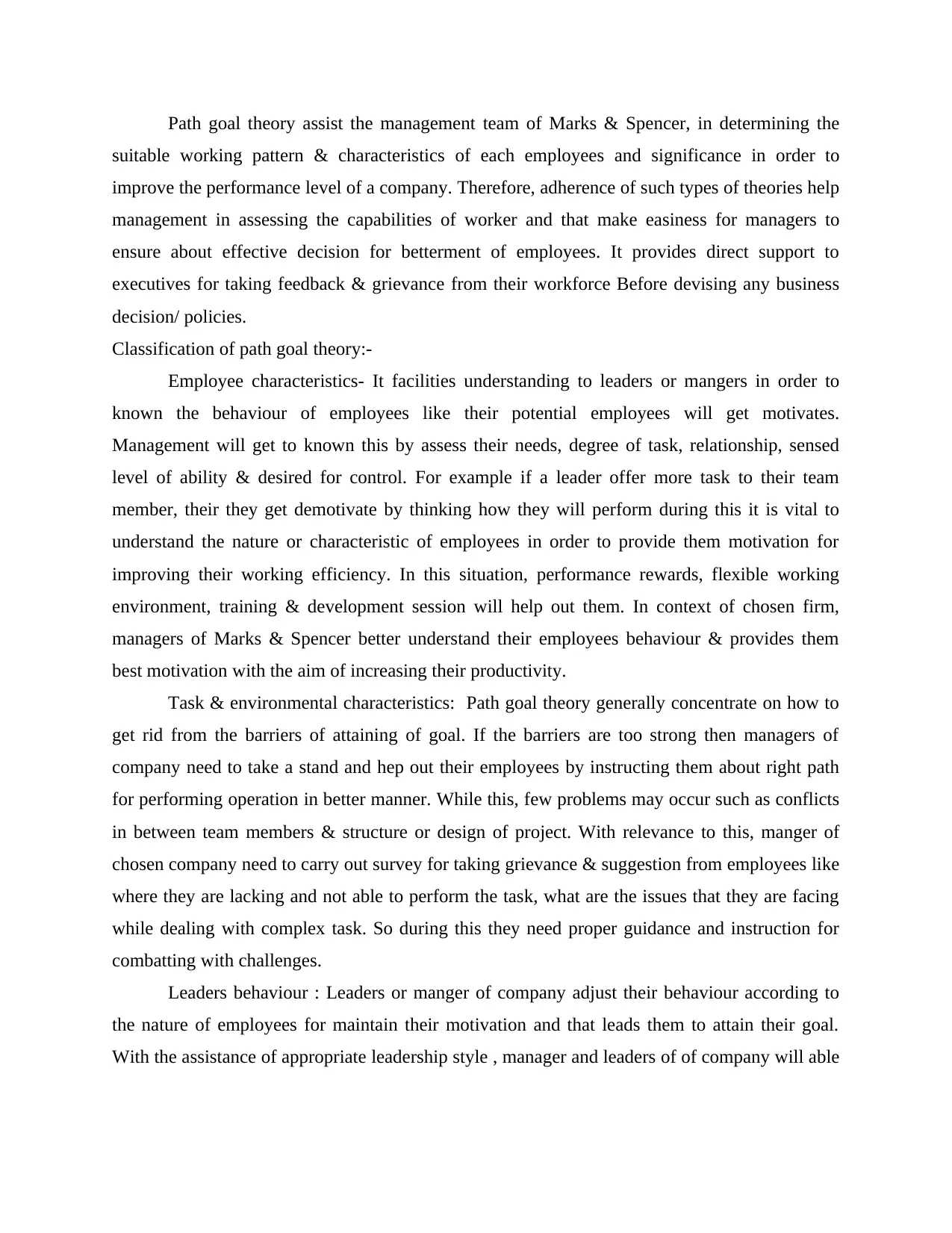
Path goal theory assist the management team of Marks & Spencer, in determining the
suitable working pattern & characteristics of each employees and significance in order to
improve the performance level of a company. Therefore, adherence of such types of theories help
management in assessing the capabilities of worker and that make easiness for managers to
ensure about effective decision for betterment of employees. It provides direct support to
executives for taking feedback & grievance from their workforce Before devising any business
decision/ policies.
Classification of path goal theory:-
Employee characteristics- It facilities understanding to leaders or mangers in order to
known the behaviour of employees like their potential employees will get motivates.
Management will get to known this by assess their needs, degree of task, relationship, sensed
level of ability & desired for control. For example if a leader offer more task to their team
member, their they get demotivate by thinking how they will perform during this it is vital to
understand the nature or characteristic of employees in order to provide them motivation for
improving their working efficiency. In this situation, performance rewards, flexible working
environment, training & development session will help out them. In context of chosen firm,
managers of Marks & Spencer better understand their employees behaviour & provides them
best motivation with the aim of increasing their productivity.
Task & environmental characteristics: Path goal theory generally concentrate on how to
get rid from the barriers of attaining of goal. If the barriers are too strong then managers of
company need to take a stand and hep out their employees by instructing them about right path
for performing operation in better manner. While this, few problems may occur such as conflicts
in between team members & structure or design of project. With relevance to this, manger of
chosen company need to carry out survey for taking grievance & suggestion from employees like
where they are lacking and not able to perform the task, what are the issues that they are facing
while dealing with complex task. So during this they need proper guidance and instruction for
combatting with challenges.
Leaders behaviour : Leaders or manger of company adjust their behaviour according to
the nature of employees for maintain their motivation and that leads them to attain their goal.
With the assistance of appropriate leadership style , manager and leaders of of company will able
suitable working pattern & characteristics of each employees and significance in order to
improve the performance level of a company. Therefore, adherence of such types of theories help
management in assessing the capabilities of worker and that make easiness for managers to
ensure about effective decision for betterment of employees. It provides direct support to
executives for taking feedback & grievance from their workforce Before devising any business
decision/ policies.
Classification of path goal theory:-
Employee characteristics- It facilities understanding to leaders or mangers in order to
known the behaviour of employees like their potential employees will get motivates.
Management will get to known this by assess their needs, degree of task, relationship, sensed
level of ability & desired for control. For example if a leader offer more task to their team
member, their they get demotivate by thinking how they will perform during this it is vital to
understand the nature or characteristic of employees in order to provide them motivation for
improving their working efficiency. In this situation, performance rewards, flexible working
environment, training & development session will help out them. In context of chosen firm,
managers of Marks & Spencer better understand their employees behaviour & provides them
best motivation with the aim of increasing their productivity.
Task & environmental characteristics: Path goal theory generally concentrate on how to
get rid from the barriers of attaining of goal. If the barriers are too strong then managers of
company need to take a stand and hep out their employees by instructing them about right path
for performing operation in better manner. While this, few problems may occur such as conflicts
in between team members & structure or design of project. With relevance to this, manger of
chosen company need to carry out survey for taking grievance & suggestion from employees like
where they are lacking and not able to perform the task, what are the issues that they are facing
while dealing with complex task. So during this they need proper guidance and instruction for
combatting with challenges.
Leaders behaviour : Leaders or manger of company adjust their behaviour according to
the nature of employees for maintain their motivation and that leads them to attain their goal.
With the assistance of appropriate leadership style , manager and leaders of of company will able
Secure Best Marks with AI Grader
Need help grading? Try our AI Grader for instant feedback on your assignments.
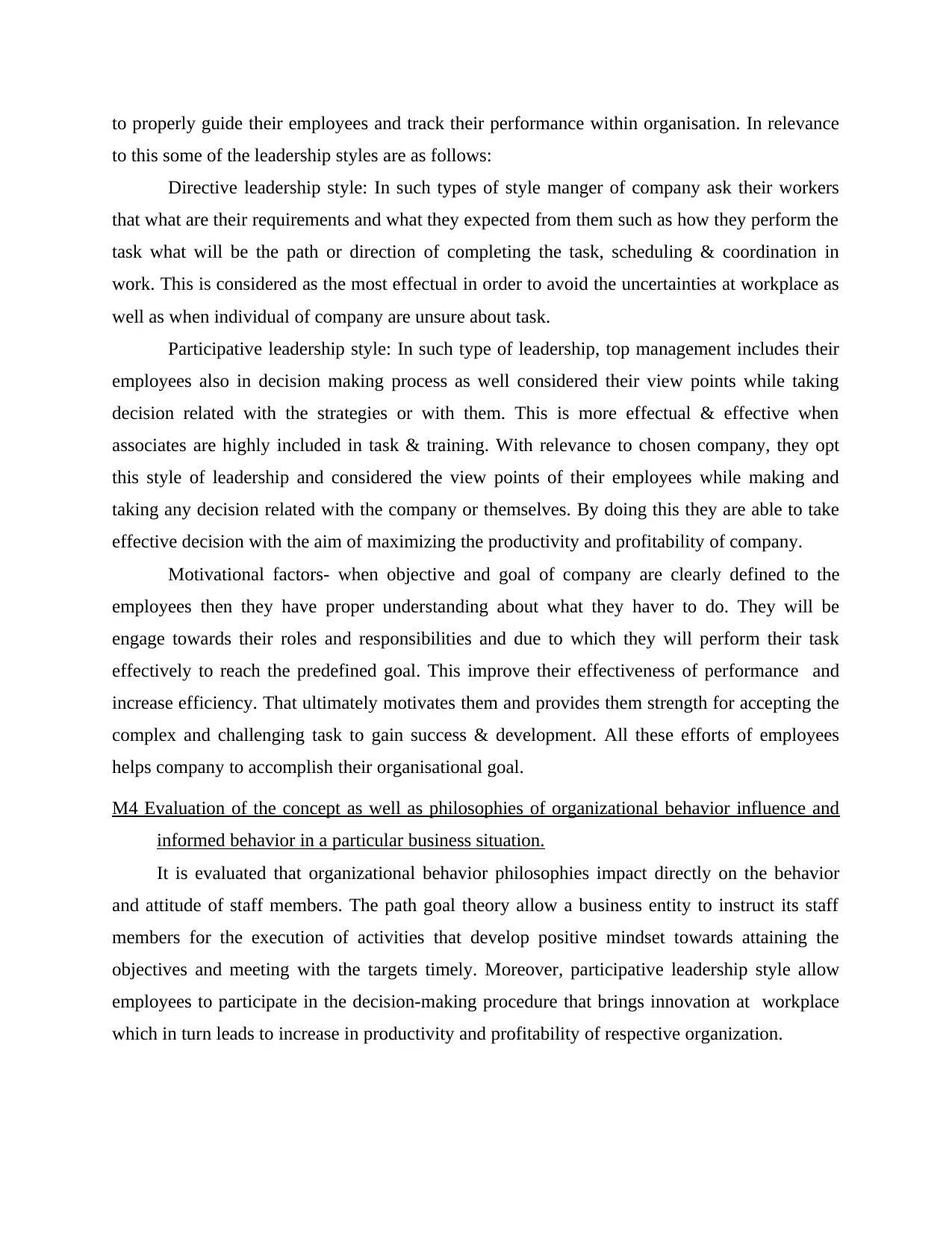
to properly guide their employees and track their performance within organisation. In relevance
to this some of the leadership styles are as follows:
Directive leadership style: In such types of style manger of company ask their workers
that what are their requirements and what they expected from them such as how they perform the
task what will be the path or direction of completing the task, scheduling & coordination in
work. This is considered as the most effectual in order to avoid the uncertainties at workplace as
well as when individual of company are unsure about task.
Participative leadership style: In such type of leadership, top management includes their
employees also in decision making process as well considered their view points while taking
decision related with the strategies or with them. This is more effectual & effective when
associates are highly included in task & training. With relevance to chosen company, they opt
this style of leadership and considered the view points of their employees while making and
taking any decision related with the company or themselves. By doing this they are able to take
effective decision with the aim of maximizing the productivity and profitability of company.
Motivational factors- when objective and goal of company are clearly defined to the
employees then they have proper understanding about what they haver to do. They will be
engage towards their roles and responsibilities and due to which they will perform their task
effectively to reach the predefined goal. This improve their effectiveness of performance and
increase efficiency. That ultimately motivates them and provides them strength for accepting the
complex and challenging task to gain success & development. All these efforts of employees
helps company to accomplish their organisational goal.
M4 Evaluation of the concept as well as philosophies of organizational behavior influence and
informed behavior in a particular business situation.
It is evaluated that organizational behavior philosophies impact directly on the behavior
and attitude of staff members. The path goal theory allow a business entity to instruct its staff
members for the execution of activities that develop positive mindset towards attaining the
objectives and meeting with the targets timely. Moreover, participative leadership style allow
employees to participate in the decision-making procedure that brings innovation at workplace
which in turn leads to increase in productivity and profitability of respective organization.
to this some of the leadership styles are as follows:
Directive leadership style: In such types of style manger of company ask their workers
that what are their requirements and what they expected from them such as how they perform the
task what will be the path or direction of completing the task, scheduling & coordination in
work. This is considered as the most effectual in order to avoid the uncertainties at workplace as
well as when individual of company are unsure about task.
Participative leadership style: In such type of leadership, top management includes their
employees also in decision making process as well considered their view points while taking
decision related with the strategies or with them. This is more effectual & effective when
associates are highly included in task & training. With relevance to chosen company, they opt
this style of leadership and considered the view points of their employees while making and
taking any decision related with the company or themselves. By doing this they are able to take
effective decision with the aim of maximizing the productivity and profitability of company.
Motivational factors- when objective and goal of company are clearly defined to the
employees then they have proper understanding about what they haver to do. They will be
engage towards their roles and responsibilities and due to which they will perform their task
effectively to reach the predefined goal. This improve their effectiveness of performance and
increase efficiency. That ultimately motivates them and provides them strength for accepting the
complex and challenging task to gain success & development. All these efforts of employees
helps company to accomplish their organisational goal.
M4 Evaluation of the concept as well as philosophies of organizational behavior influence and
informed behavior in a particular business situation.
It is evaluated that organizational behavior philosophies impact directly on the behavior
and attitude of staff members. The path goal theory allow a business entity to instruct its staff
members for the execution of activities that develop positive mindset towards attaining the
objectives and meeting with the targets timely. Moreover, participative leadership style allow
employees to participate in the decision-making procedure that brings innovation at workplace
which in turn leads to increase in productivity and profitability of respective organization.
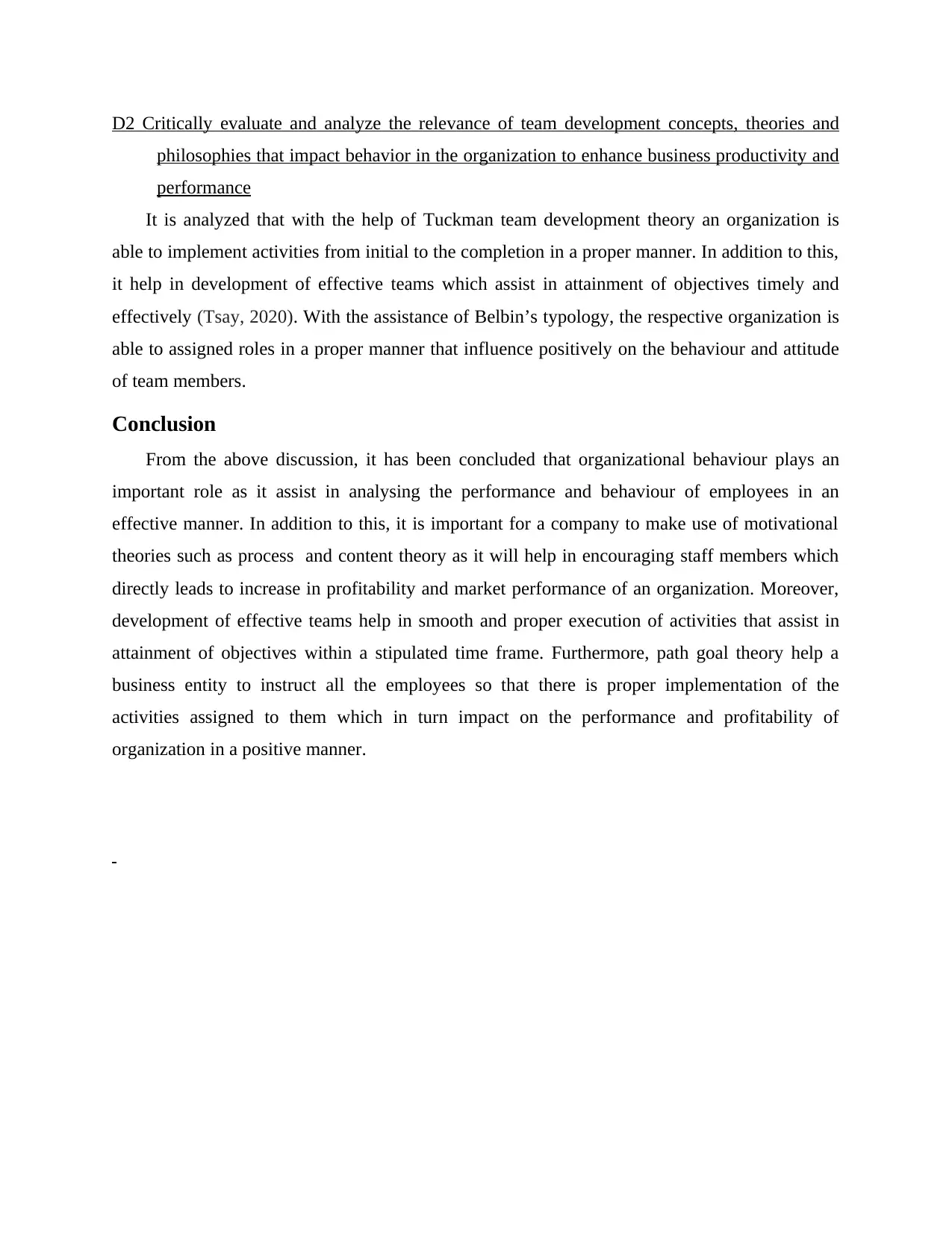
D2 Critically evaluate and analyze the relevance of team development concepts, theories and
philosophies that impact behavior in the organization to enhance business productivity and
performance
It is analyzed that with the help of Tuckman team development theory an organization is
able to implement activities from initial to the completion in a proper manner. In addition to this,
it help in development of effective teams which assist in attainment of objectives timely and
effectively (Tsay, 2020). With the assistance of Belbin’s typology, the respective organization is
able to assigned roles in a proper manner that influence positively on the behaviour and attitude
of team members.
Conclusion
From the above discussion, it has been concluded that organizational behaviour plays an
important role as it assist in analysing the performance and behaviour of employees in an
effective manner. In addition to this, it is important for a company to make use of motivational
theories such as process and content theory as it will help in encouraging staff members which
directly leads to increase in profitability and market performance of an organization. Moreover,
development of effective teams help in smooth and proper execution of activities that assist in
attainment of objectives within a stipulated time frame. Furthermore, path goal theory help a
business entity to instruct all the employees so that there is proper implementation of the
activities assigned to them which in turn impact on the performance and profitability of
organization in a positive manner.
philosophies that impact behavior in the organization to enhance business productivity and
performance
It is analyzed that with the help of Tuckman team development theory an organization is
able to implement activities from initial to the completion in a proper manner. In addition to this,
it help in development of effective teams which assist in attainment of objectives timely and
effectively (Tsay, 2020). With the assistance of Belbin’s typology, the respective organization is
able to assigned roles in a proper manner that influence positively on the behaviour and attitude
of team members.
Conclusion
From the above discussion, it has been concluded that organizational behaviour plays an
important role as it assist in analysing the performance and behaviour of employees in an
effective manner. In addition to this, it is important for a company to make use of motivational
theories such as process and content theory as it will help in encouraging staff members which
directly leads to increase in profitability and market performance of an organization. Moreover,
development of effective teams help in smooth and proper execution of activities that assist in
attainment of objectives within a stipulated time frame. Furthermore, path goal theory help a
business entity to instruct all the employees so that there is proper implementation of the
activities assigned to them which in turn impact on the performance and profitability of
organization in a positive manner.
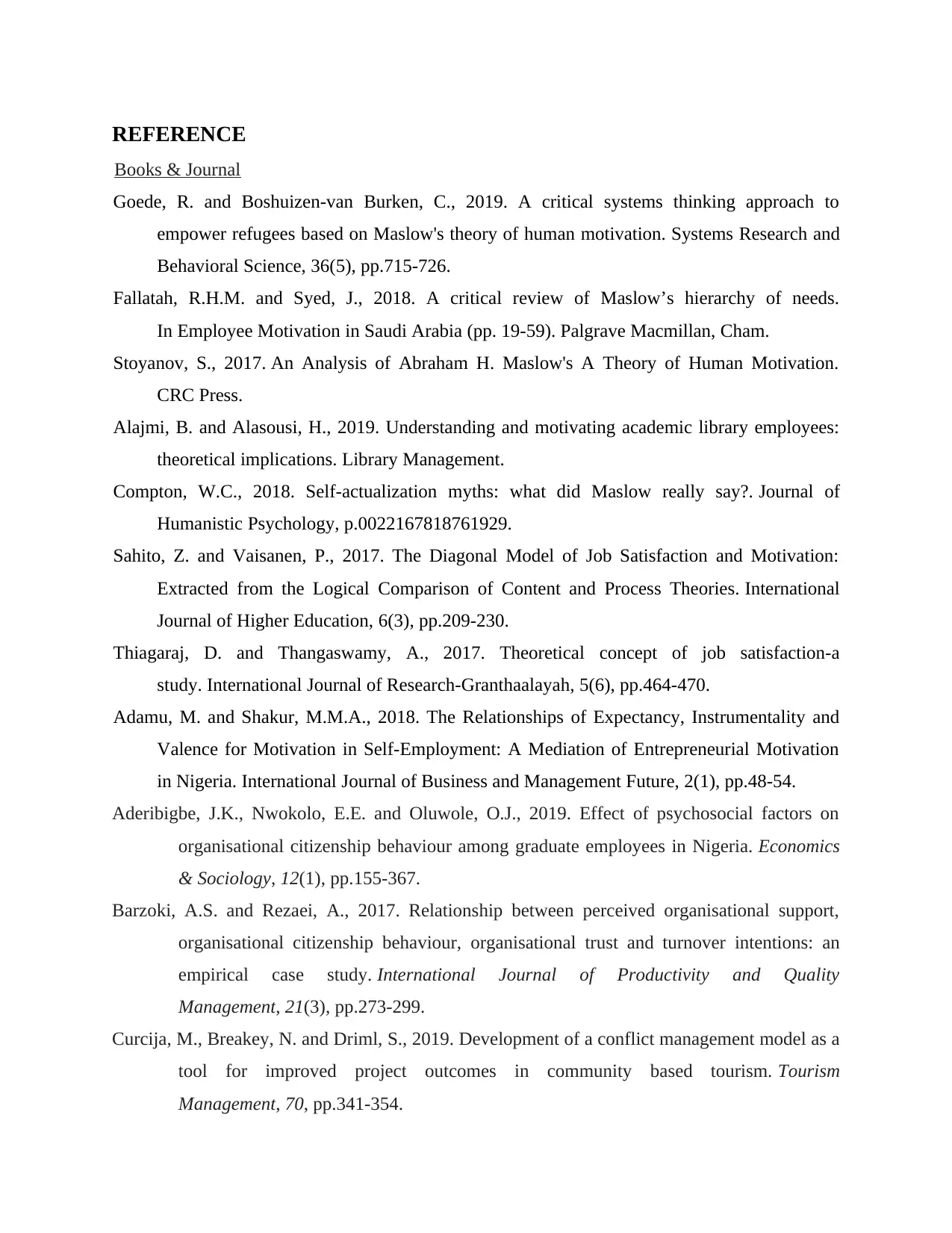
REFERENCE
Books & Journal
Goede, R. and Boshuizen‐van Burken, C., 2019. A critical systems thinking approach to
empower refugees based on Maslow's theory of human motivation. Systems Research and
Behavioral Science, 36(5), pp.715-726.
Fallatah, R.H.M. and Syed, J., 2018. A critical review of Maslow’s hierarchy of needs.
In Employee Motivation in Saudi Arabia (pp. 19-59). Palgrave Macmillan, Cham.
Stoyanov, S., 2017. An Analysis of Abraham H. Maslow's A Theory of Human Motivation.
CRC Press.
Alajmi, B. and Alasousi, H., 2019. Understanding and motivating academic library employees:
theoretical implications. Library Management.
Compton, W.C., 2018. Self-actualization myths: what did Maslow really say?. Journal of
Humanistic Psychology, p.0022167818761929.
Sahito, Z. and Vaisanen, P., 2017. The Diagonal Model of Job Satisfaction and Motivation:
Extracted from the Logical Comparison of Content and Process Theories. International
Journal of Higher Education, 6(3), pp.209-230.
Thiagaraj, D. and Thangaswamy, A., 2017. Theoretical concept of job satisfaction-a
study. International Journal of Research-Granthaalayah, 5(6), pp.464-470.
Adamu, M. and Shakur, M.M.A., 2018. The Relationships of Expectancy, Instrumentality and
Valence for Motivation in Self-Employment: A Mediation of Entrepreneurial Motivation
in Nigeria. International Journal of Business and Management Future, 2(1), pp.48-54.
Aderibigbe, J.K., Nwokolo, E.E. and Oluwole, O.J., 2019. Effect of psychosocial factors on
organisational citizenship behaviour among graduate employees in Nigeria. Economics
& Sociology, 12(1), pp.155-367.
Barzoki, A.S. and Rezaei, A., 2017. Relationship between perceived organisational support,
organisational citizenship behaviour, organisational trust and turnover intentions: an
empirical case study. International Journal of Productivity and Quality
Management, 21(3), pp.273-299.
Curcija, M., Breakey, N. and Driml, S., 2019. Development of a conflict management model as a
tool for improved project outcomes in community based tourism. Tourism
Management, 70, pp.341-354.
Books & Journal
Goede, R. and Boshuizen‐van Burken, C., 2019. A critical systems thinking approach to
empower refugees based on Maslow's theory of human motivation. Systems Research and
Behavioral Science, 36(5), pp.715-726.
Fallatah, R.H.M. and Syed, J., 2018. A critical review of Maslow’s hierarchy of needs.
In Employee Motivation in Saudi Arabia (pp. 19-59). Palgrave Macmillan, Cham.
Stoyanov, S., 2017. An Analysis of Abraham H. Maslow's A Theory of Human Motivation.
CRC Press.
Alajmi, B. and Alasousi, H., 2019. Understanding and motivating academic library employees:
theoretical implications. Library Management.
Compton, W.C., 2018. Self-actualization myths: what did Maslow really say?. Journal of
Humanistic Psychology, p.0022167818761929.
Sahito, Z. and Vaisanen, P., 2017. The Diagonal Model of Job Satisfaction and Motivation:
Extracted from the Logical Comparison of Content and Process Theories. International
Journal of Higher Education, 6(3), pp.209-230.
Thiagaraj, D. and Thangaswamy, A., 2017. Theoretical concept of job satisfaction-a
study. International Journal of Research-Granthaalayah, 5(6), pp.464-470.
Adamu, M. and Shakur, M.M.A., 2018. The Relationships of Expectancy, Instrumentality and
Valence for Motivation in Self-Employment: A Mediation of Entrepreneurial Motivation
in Nigeria. International Journal of Business and Management Future, 2(1), pp.48-54.
Aderibigbe, J.K., Nwokolo, E.E. and Oluwole, O.J., 2019. Effect of psychosocial factors on
organisational citizenship behaviour among graduate employees in Nigeria. Economics
& Sociology, 12(1), pp.155-367.
Barzoki, A.S. and Rezaei, A., 2017. Relationship between perceived organisational support,
organisational citizenship behaviour, organisational trust and turnover intentions: an
empirical case study. International Journal of Productivity and Quality
Management, 21(3), pp.273-299.
Curcija, M., Breakey, N. and Driml, S., 2019. Development of a conflict management model as a
tool for improved project outcomes in community based tourism. Tourism
Management, 70, pp.341-354.
Paraphrase This Document
Need a fresh take? Get an instant paraphrase of this document with our AI Paraphraser
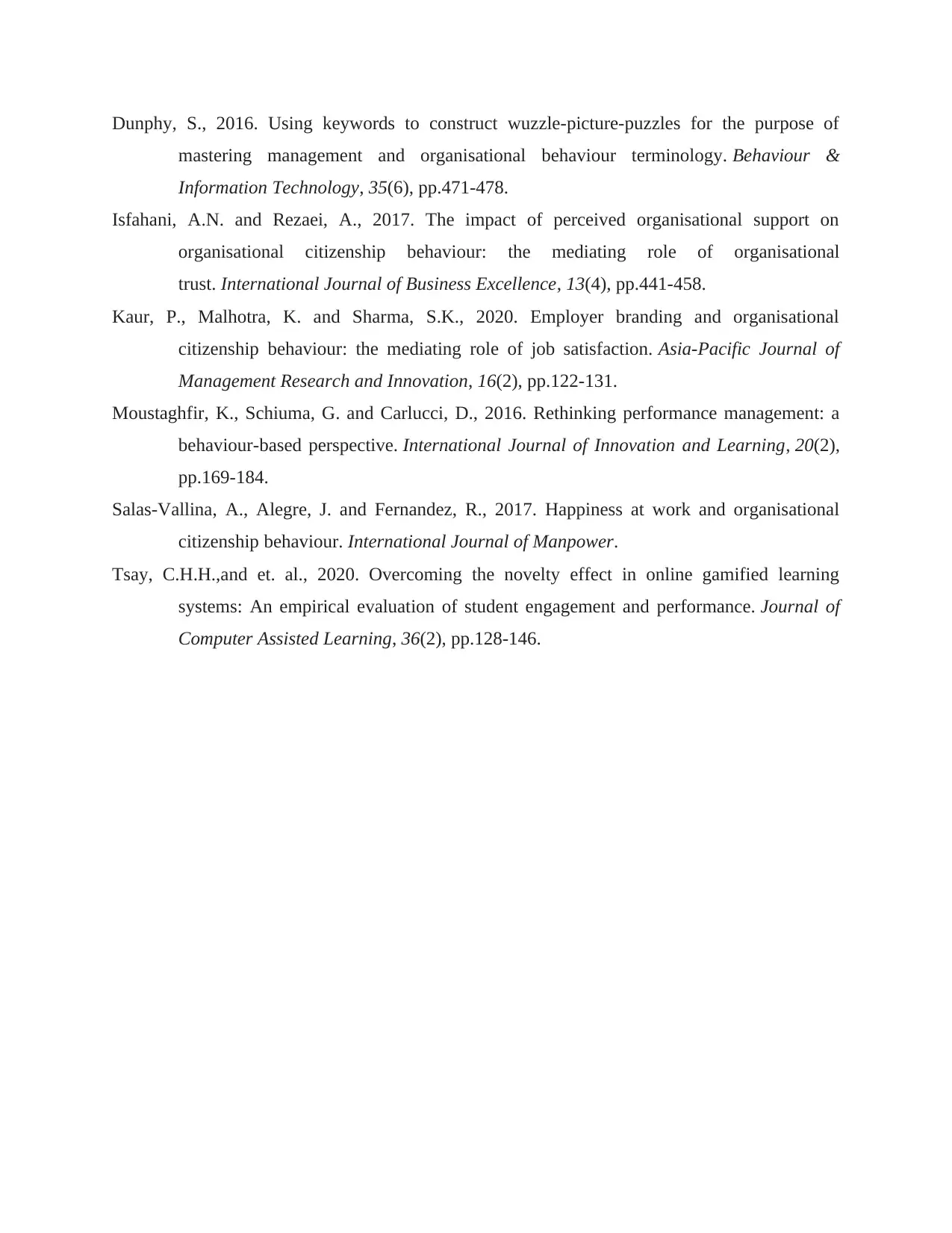
Dunphy, S., 2016. Using keywords to construct wuzzle-picture-puzzles for the purpose of
mastering management and organisational behaviour terminology. Behaviour &
Information Technology, 35(6), pp.471-478.
Isfahani, A.N. and Rezaei, A., 2017. The impact of perceived organisational support on
organisational citizenship behaviour: the mediating role of organisational
trust. International Journal of Business Excellence, 13(4), pp.441-458.
Kaur, P., Malhotra, K. and Sharma, S.K., 2020. Employer branding and organisational
citizenship behaviour: the mediating role of job satisfaction. Asia-Pacific Journal of
Management Research and Innovation, 16(2), pp.122-131.
Moustaghfir, K., Schiuma, G. and Carlucci, D., 2016. Rethinking performance management: a
behaviour-based perspective. International Journal of Innovation and Learning, 20(2),
pp.169-184.
Salas-Vallina, A., Alegre, J. and Fernandez, R., 2017. Happiness at work and organisational
citizenship behaviour. International Journal of Manpower.
Tsay, C.H.H.,and et. al., 2020. Overcoming the novelty effect in online gamified learning
systems: An empirical evaluation of student engagement and performance. Journal of
Computer Assisted Learning, 36(2), pp.128-146.
mastering management and organisational behaviour terminology. Behaviour &
Information Technology, 35(6), pp.471-478.
Isfahani, A.N. and Rezaei, A., 2017. The impact of perceived organisational support on
organisational citizenship behaviour: the mediating role of organisational
trust. International Journal of Business Excellence, 13(4), pp.441-458.
Kaur, P., Malhotra, K. and Sharma, S.K., 2020. Employer branding and organisational
citizenship behaviour: the mediating role of job satisfaction. Asia-Pacific Journal of
Management Research and Innovation, 16(2), pp.122-131.
Moustaghfir, K., Schiuma, G. and Carlucci, D., 2016. Rethinking performance management: a
behaviour-based perspective. International Journal of Innovation and Learning, 20(2),
pp.169-184.
Salas-Vallina, A., Alegre, J. and Fernandez, R., 2017. Happiness at work and organisational
citizenship behaviour. International Journal of Manpower.
Tsay, C.H.H.,and et. al., 2020. Overcoming the novelty effect in online gamified learning
systems: An empirical evaluation of student engagement and performance. Journal of
Computer Assisted Learning, 36(2), pp.128-146.
1 out of 20
Related Documents
Your All-in-One AI-Powered Toolkit for Academic Success.
+13062052269
info@desklib.com
Available 24*7 on WhatsApp / Email
![[object Object]](/_next/static/media/star-bottom.7253800d.svg)
Unlock your academic potential
© 2024 | Zucol Services PVT LTD | All rights reserved.





